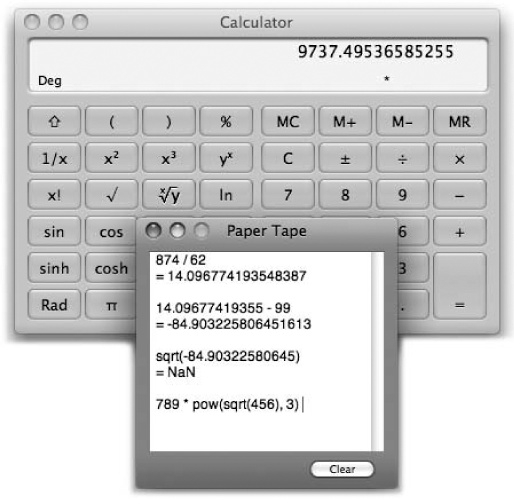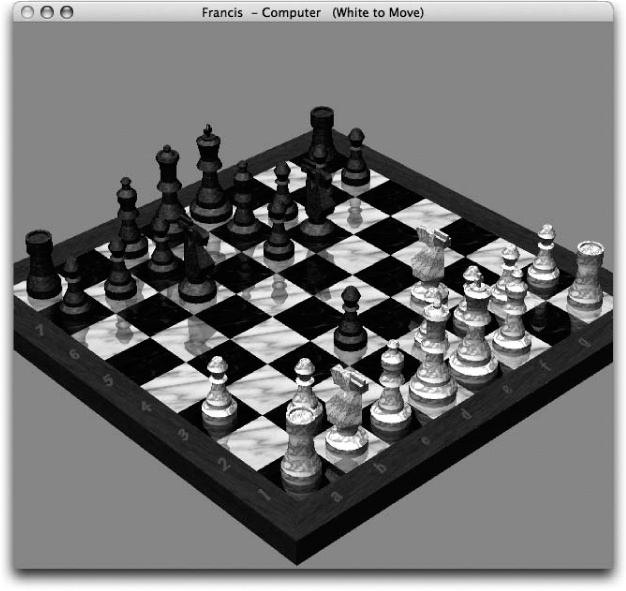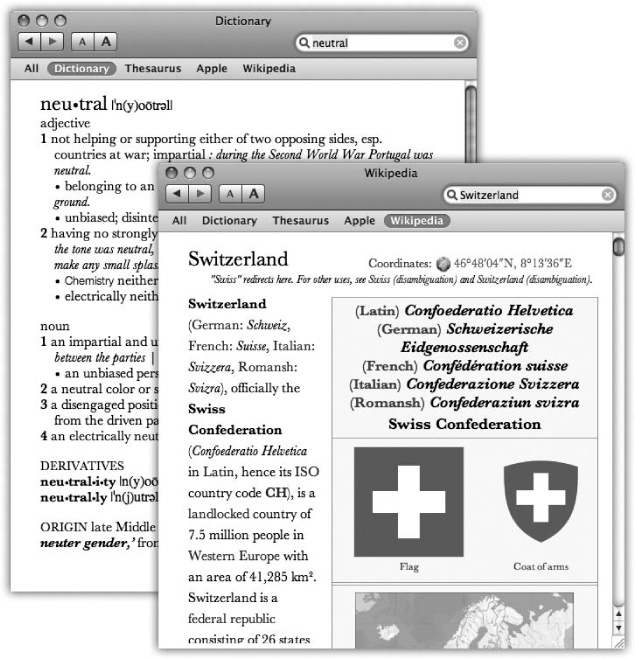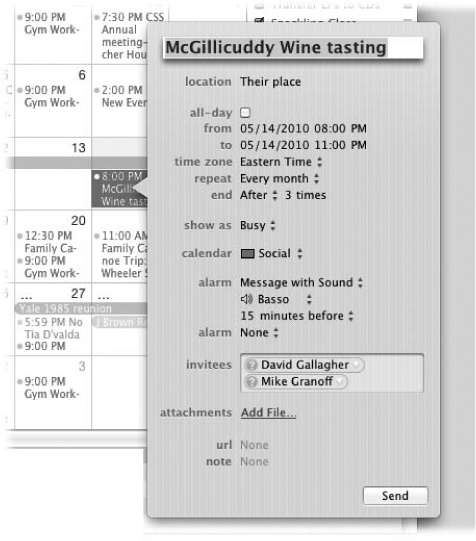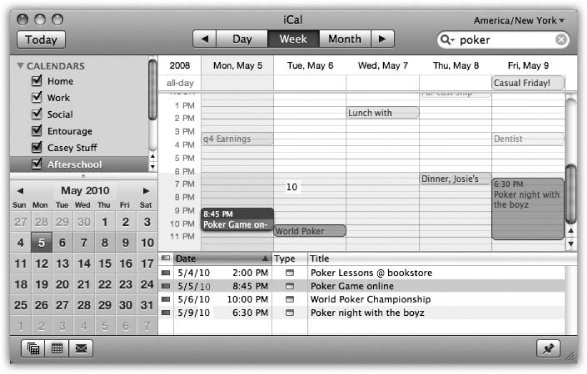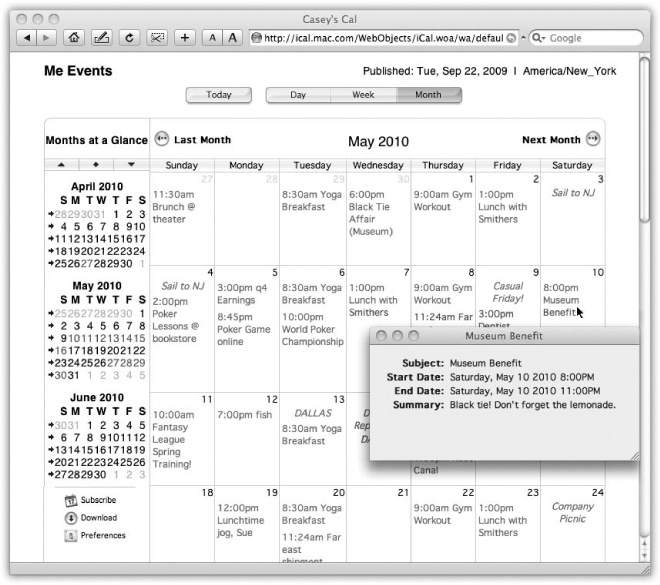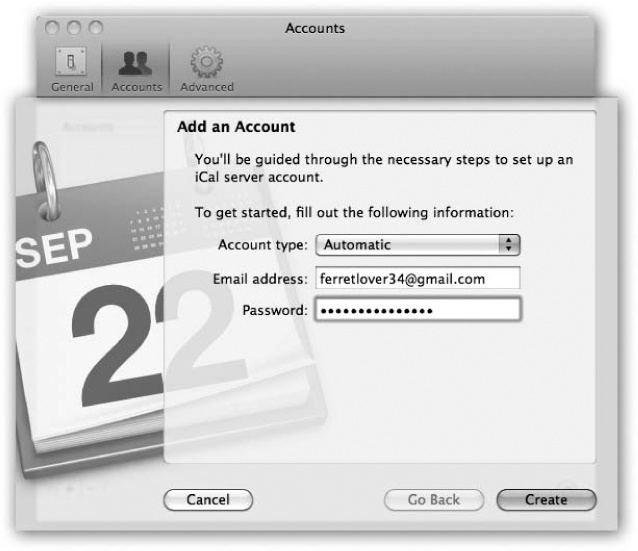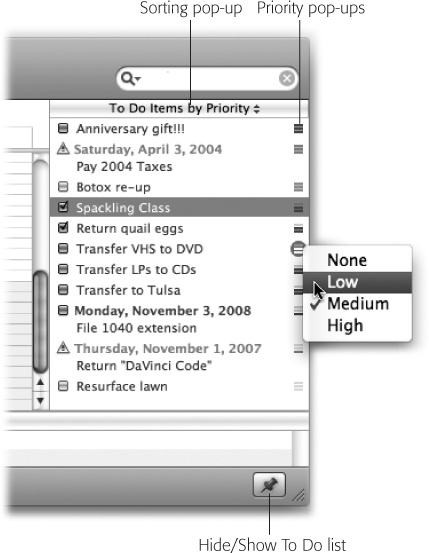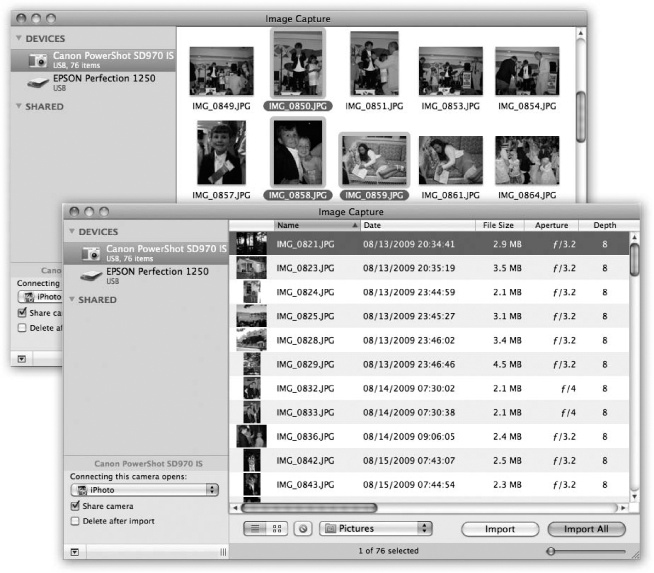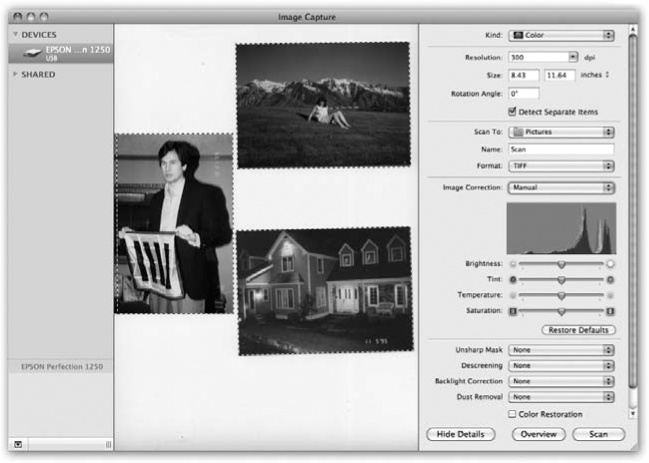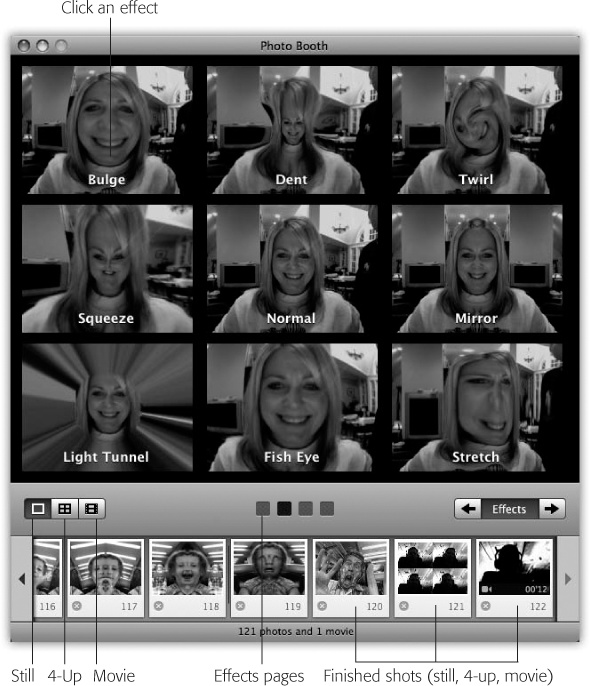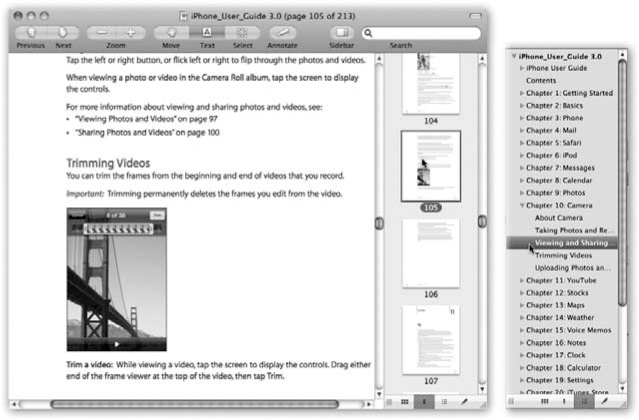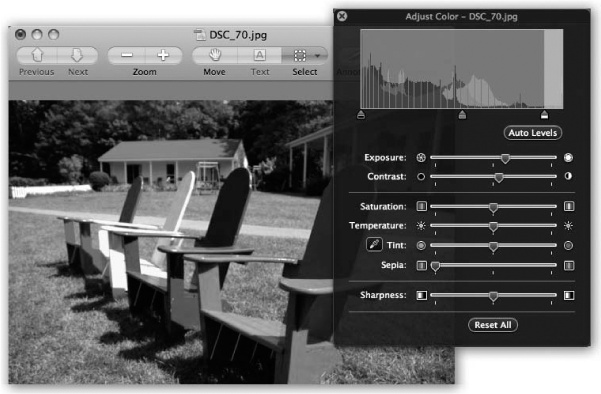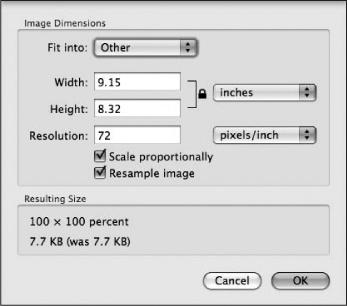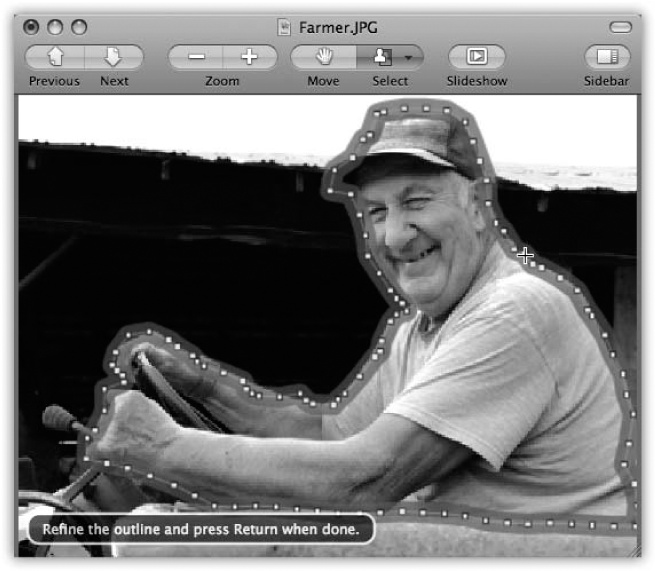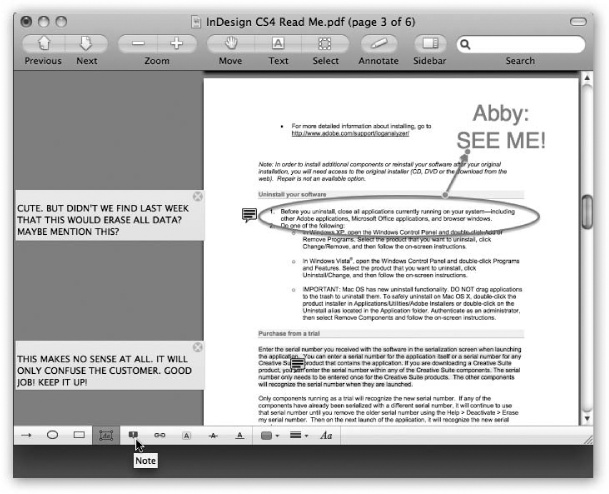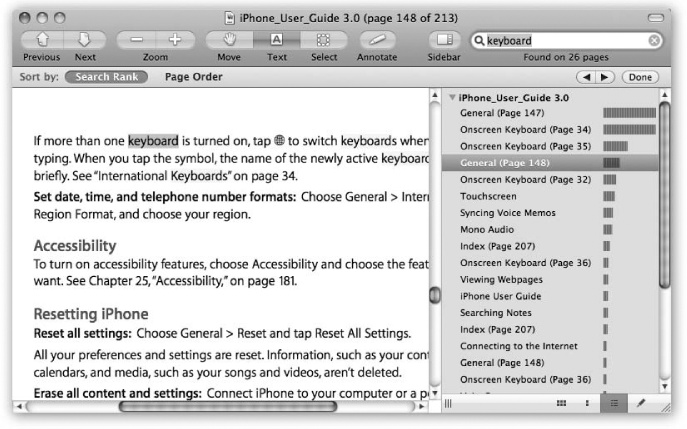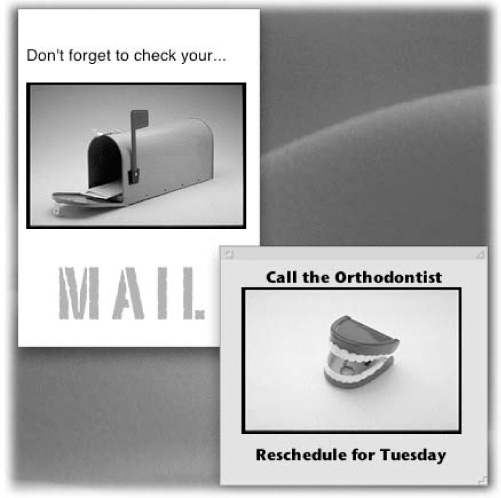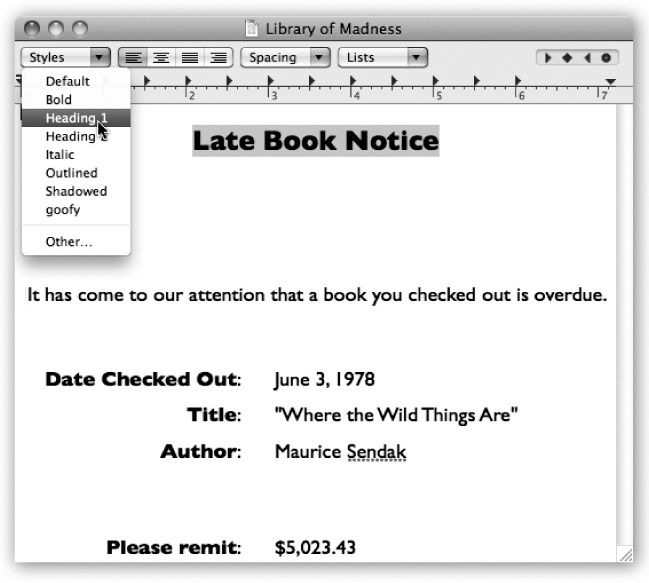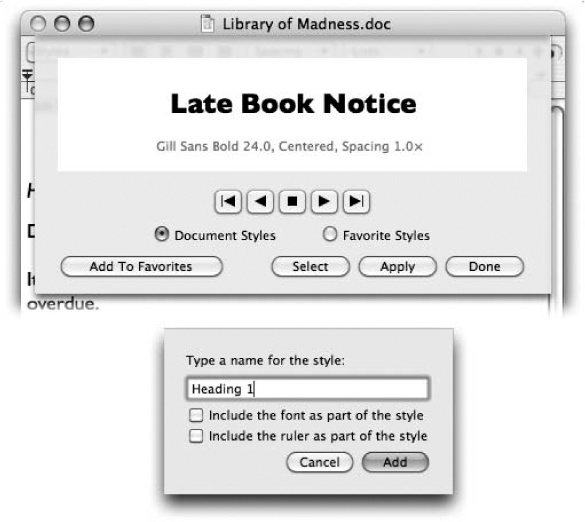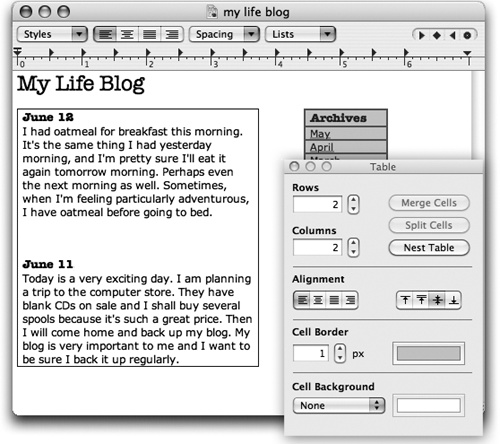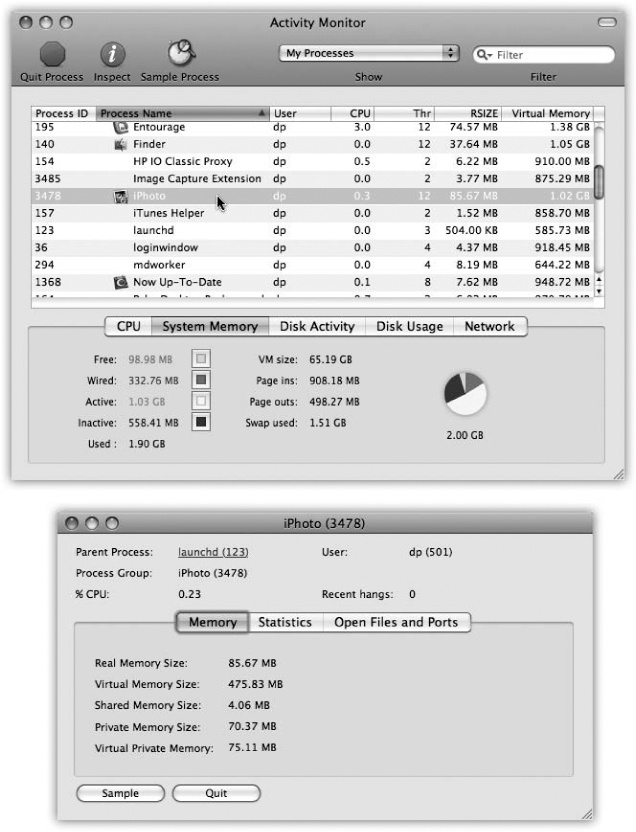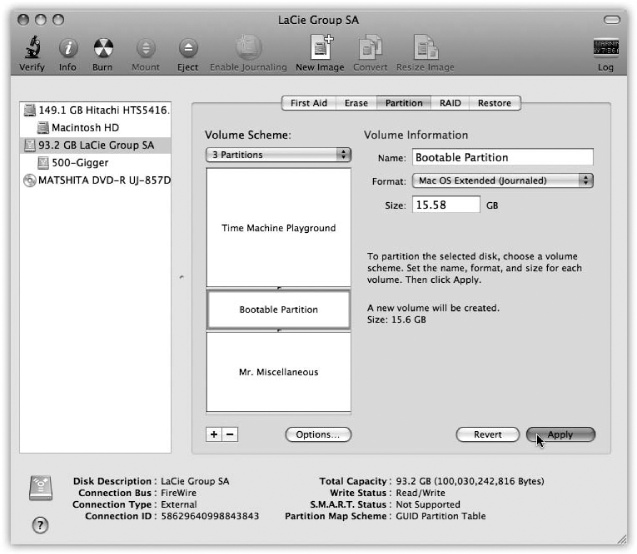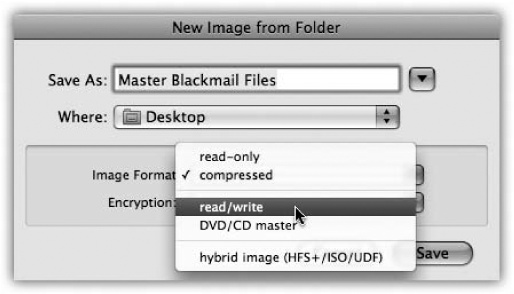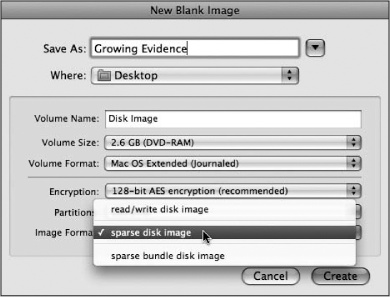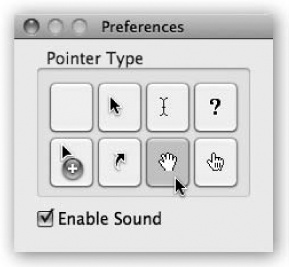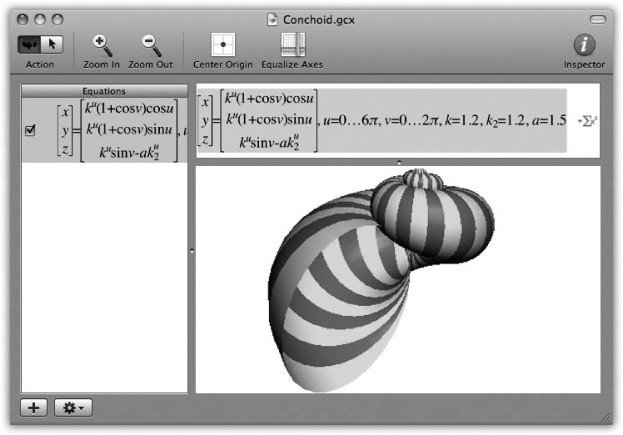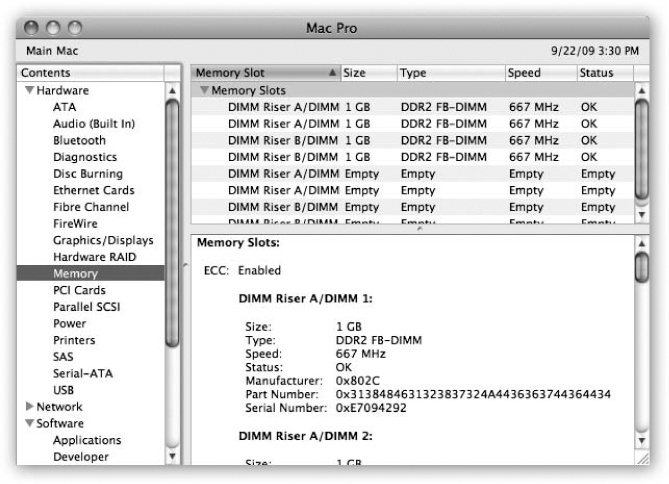Right out of the box, Mac OS X comes with a healthy assortment of about 50 freebies: programs for sending email, writing documents, doing math, even playing games. Some have been around for years. Others, though, have been given extreme makeovers in Snow Leopard. They’re designed not only to show off some of Mac OS X’s most dramatic technologies, but also to let you get real work done without having to invest in additional software.
A broad assortment of programs sits in the Applications folder in the main hard drive window, and another couple dozen less frequently used apps await in the Applications→Utilities folder.
This chapter guides you through every item in your new software library, one program at a time. (Of course, your Applications list may vary. Apple might have blessed your particular Mac model with some bonus programs, or you may have downloaded or installed some on your own.)
Tip
A reminder: You can jump straight to the Applications folder in the Finder by pressing Shift-⌘-A (the shortcut for Go→Applications), or by clicking the Applications folder icon in the Sidebar. You might consider adding the Application folder’s icon to the Dock, too, so you can access it no matter what program you’re in. Shift-⌘-U (or Go→Utilities) takes you, of course, to the Utilities folder.
The Address Book is a database that stores names, addresses, email addresses, phone numbers, and other contact information. See To Do List: Mail/iCal Joint Custody.
This software-robot program is introduced in Chapter 7.
The Calculator is much more than a simple four-function memory calculator. It can also act as a scientific calculator for students and scientists, a conversion calculator for metric and U.S. measures, and even a currency calculator for world travelers.
The little Calculator widget in the Dashboard is quicker to open, but the standalone Calculator program is far more powerful. For example:
Calculator has three modes: Basic, Advanced, and Programmer (Figure 10-1). Switch among them by choosing from the View menu (or pressing ⌘-1 for Basic, ⌘-2 for Advanced, or ⌘-3 for Programmer).
You can operate Calculator by clicking the onscreen buttons, but it’s much easier to press the corresponding number and symbol keys on your keyboard.
As you go, you can make Calculator speak each key you press. The Mac’s voice ensures that you don’t mistype as you keep your eyes on the receipts in front of you, typing by touch.
Just choose Speech→Speak Button Pressed to turn this feature on or off. (You choose which voice does the talking in the Speech panel of System Preferences.)
Tip
If you have a pre-2008 laptop, you probably have an embedded numeric keypad, superimposed on the right side of the keyboard and labeled on the keys in a different color ink. When you press the Fn key in the lower-left corner of the keyboard, typing these keys produces the numbers instead of the letters. (You can also press the NumLock key to stay in number mode, so you don’t have to keep pressing Fn.)
Press the C key to clear the calculator display.
Once you’ve calculated a result, you can copy it (using Edit→Copy, or ⌘-C) and paste it directly into another program.
Calculator even offers Reverse Polish Notation (RPN), a system of entering numbers that’s popular with some mathematicians, programmers, and engineers, because it lets them omit parentheses. Choose View→RPN to turn it on and off.
Tip
How cool is this? In most programs, you don’t need Calculator or even a Dashboard widget. Just highlight an equation (like 56*32.1-517) right in your document, and press ⌘-Shift-8. Presto—Mac OS X replaces the equation with the right answer. This trick works in TextEdit, Mail, Entourage, FileMaker, and many other programs.
And if you ever find that it doesn’t work, remember that the Spotlight menu is now a calculator, too. Type or paste an equation into the Spotlight search box; instantly, the answer appears in the results menu.
Figure 10-1. The Calculator program offers a four-function Basic mode, a full-blown scientific calculator mode, and a programmer’s calculator (shown here, and capable of hex, octal, decimal, and binary notation). The first two modes offer a “paper tape” feature (View→Show Paper Tape) that lets you correct errors made way back in a calculation. To edit one of the numbers on the paper tape, drag through it, retype, and then click Recalculate Totals. You can also save the tape as a text file by choosing File→Save Tape As, or print it by selecting File→Print Tape.
Calculator is more than a calculator; it’s also a conversion program. No matter what units you’re trying to convert—meters, grams, inches, miles per hour, money—Calculator is ready.
Now, the truth is, the Units Converter widget in Dashboard is simpler and better than this older Calculator feature. But if you’ve already got Calculator open, here’s the drill:
Clear the calculator (for example, type the letter C on your keyboard). Type in the starting measurement.
To convert 48 degrees Celsius to Fahrenheit, for example, type 48.
From the Convert menu, choose the kind of conversion you want.
In this case, choose Temperature. When you’re done choosing, a dialog box appears.
Use the pop-up menus to specify which units you want to convert to and from.
To convert Celsius to Fahrenheit, choose Celsius from the first pop-up menu, and Fahrenheit from the second.
Click OK.
That’s it. The Calculator displays the result—in degrees Fahrenheit, in this example.
The next time you want to make this kind of calculation, you can skip steps 2, 3, and 4. Instead, just choose your desired conversion from the Convert→Recent Conversions submenu.
Calculator is especially amazing when it comes to currency conversions—from pesos to American dollars, for example—because it actually does its homework. It goes online to download up-to-the-minute currency rates to ensure that the conversion is accurate. (Choose Convert→Update Currency Exchange Rates.)
Mac OS X comes with only one game, but it’s a beauty (Figure 10-2). It’s a traditional chess game played on a gorgeously rendered board with a set of realistic 3-D pieces.
Note
The program is actually a sophisticated Unix-based chess program, Sjeng Chess, that Apple packaged up in a new wrapper.
When you launch Chess, you’re presented with a fresh, new game that’s set up in Human vs. Computer mode—meaning that you, the Human (light-colored pieces) get to play against the Computer (your Mac, on the dark side). Drag the chess piece of your choice into position on the board, and the game is afoot.
If you choose Game→New Game, however, you’re offered a pop-up menu with choices like Human vs. Computer, Human vs. Human, and so on. If you switch the pop-up menu to Computer vs. Human, you and your Mac trade places; the Mac takes the white side of the board and opens the game with the first move, and you play the black side.
Tip
The same New Game dialog box also offers a pop-up menu called Variant, which offers three other chess-like games: Crazyhouse, Suicide, and Losers. The Chess help screens (choose Help→Chess Help, and then click “Starting a new chess game”) explain these variations.
Figure 10-2. You don’t have to be terribly exact about grabbing the chess pieces when it’s time to make your move. Just click anywhere within a piece’s current square to drag it into a new position on the board (shown here in its Marble incarnation). And how did this chess board get rotated like this? Because you can grab a corner of the board and rotate it in 3-D space. Cool!
On some night when the video store is closed and you’re desperate for entertainment, you might also want to try the Computer vs. Computer option, which pits your Mac against itself. Pour yourself a beer, open a bag of chips, and settle in to watch until someone—either the Mac or the Mac—gains victory.
Choose Chess→Preferences to find some useful controls like these:
Style. Apple has gone nuts with the computer-generated materials options in this program. (Is it a coincidence that Steve Jobs is also the CEO of Pixar, the computer-animation company?)
In any case, you can choose all kinds of wacky materials for the look of your game board—Wood, Metal, Marble, or Grass (?)—and for your playing pieces (Wood, Metal, Marble, or Fur).
Computer Plays. Use this slider to determine how frustrated you want to get when trying to win at Chess. The farther you drag the slider toward the Stronger side, the more calculations the computer runs before making its next move—and, thus, the harder it gets for you to outthink it. At the Faster setting, Chess won’t spend more than 5 seconds ruminating over possible moves. Drag the slider all the way to the right, however, and the program may analyze each move for as long as 10 fun-filled hours. This hardest setting, of course, makes it all but impossible to win a game (which may stretch on for a week or more anyway).
Choosing the Faster setting makes it only mildly impossible.
Speech. The two checkboxes here let you play Chess using the Mac’s built-in voice-recognition features, telling your chess pieces where to go instead of dragging them, and listening to the Mac tell you which moves it’s making. Speech Recognition has the details.
Tip
If your Chess-playing skills are less than optimal, the Moves menu will become your fast friend. The three commands tucked away there undo your last move (great for recovering from a blunder), suggest a move when you don’t have a clue what to do next, and display your opponent’s previous move (in case you failed to notice what the computer just did).
You can choose Game→Save Game to save any game in progress, so you can resume it later.
To analyze the moves making up a game, use the Game Log command, which displays the history of your game, move by move. A typical move would be recorded as “Nb8 – c6,” meaning the knight on the b8 square moved to the c6 square. Equipped with a Chess list document, you could re-create an entire game, move by move.
Dashboard, described in Chapter 5, is a true-blue, double-clickable application. As a result, you can remove its icon from your Dock, if you like.
For word nerds everywhere, the Dictionary (and thesaurus) is a blessing—a handy way to look up word definitions, pronunciations, and synonyms. To be precise, Snow Leopard comes with electronic versions of multiple reference works in one:
The complete Oxford American Writers Thesaurus.
A dictionary of Apple terms, from “A/UX” to “widget.” (Apparently there aren’t any Apple terms that begin with X, Y, or Z.)
Wikipedia. Of course, this famous open-source, citizen-created encyclopedia isn’t actually on your Mac. All Dictionary does is give you an easy way to search the online version, and display the results right in the comfy Dictionary window.
A Japanese dictionary, thesaurus, and Japanese-to-English translation dictionary.
Tip
You don’t ordinarily see the Japanese reference books. You have to turn them on in Dictionary→ Preferences.
Figure 10-3. When you open the Dictionary, it generally assumes that you want a word’s definition (top left). If you prefer to see the Wikipedia entry (lower right) at startup time instead, for example, choose Dictionary→Preferences—and drag Wikipedia upward so that it precedes New Oxford American Dictionary. That’s all there is to it!
Mac OS X also comes with about a million ways to look up a word:
Double-click the Dictionary icon. You get the window shown at top in Figure 10-3. As you type into the Spotlight-y search box, you home in on matching words; double-click a word, or highlight it and press Return, to view a full, typographically elegant definition, complete with sample sentence and pronunciation guide.
Tip
And if you don’t recognize a word in the definition, click that word to look up its definition. (Each word turns blue and underlined when you point to it, as a reminder.) You can then double-click again in that definition—and on, and on, and on.
(You can then use the History menu, the
 and
and  buttons on the toolbar, or the ⌘-[ and ⌘-] keystrokes to go back and forward in your chain of lookups.)
buttons on the toolbar, or the ⌘-[ and ⌘-] keystrokes to go back and forward in your chain of lookups.)It’s worth exploring the Dictionary→Preferences dialog box, by the way. There, you can choose U.S. or British pronunciations and adjust the font size.
Press F12. Yes, the Dictionary is one of the widgets in Dashboard (Calculator).
Control-click (right-click) a highlighted word in a Cocoa program. From the shortcut menu, choose Look Up in Dictionary. The Dictionary program opens to that word. (Or visit the Dictionary’s Preferences box and choose “Open Dictionary panel.” Now you get a panel that pops out of the highlighted word instead.)
Use the dict:// prefix in your Web browser. This might sound a little odd, but it’s actually ultra-convenient, because it puts the dictionary right where you’re most likely to need it: on the Web.
Turns out that you can look up a word (for example, preposterous) by typing dict://preposterous into the address bar—the spot where you’d normally type http://www.whatever. When you hit Return, Mac OS X opens Dictionary automatically and presents the search results from all of its resources (dictionary, thesaurus, Apple terms, and Wikipedia).
Point to a word in a basic Mac program, and then press Control-⌘-D. That keystroke makes the definition panel sprout right from the word you were pointing to. (The advantage here, of course, is that you don’t have to highlight the word first.) “Basic Mac program,” in this case, means one of the Apple standards: Mail, Stickies, Safari, TextEdit, iChat, and so on.
Highlight a word in a basic Mac program, and then press Shift-⌘-L. That’s the keyboard shortcut for the Look Up in Dictionary Service (see Chapter 7).
The front matter of the Oxford American Dictionary (the reference pages at the beginning) is here, too. It includes some delicious writers’ tools, including guides to spelling, grammar, capitalization, punctuation, chemical elements, and clichés, along with the full text of the Declaration of Independence and the U.S. Constitution. Just choose Go→Front/Back Matter—and marvel that your Mac comes with a built-in college English course.
DVD Player, your Mac’s built-in movie projector, is described in Chapter 11.
For details on this font-management program, see Chapter 14.
This full-screen multimedia playback program is now part of Mac OS X; it’s available even on Macs that didn’t come with Apple’s slim white remote control. Chapter 15 has details.
GarageBand, Apple’s do-it-yourself music construction kit, isn’t actually part of Mac OS X. If you have a copy, that’s because it’s part of the iLife suite that comes on every new Mac (along with iMovie, iPhoto, and iWeb). There’s a crash-course bonus chapter on this book’s “Missing CD” page at www.missingmanuals.com.
In many ways, iCal is not so different from those “Hunks of the Midwest Police Stations” paper calendars people leave hanging on the walls for months past their natural life span.
But iCal offers several advantages over paper calendars. For example:
It can automate the process of entering repeating events, such as weekly staff meetings or gym workouts.
iCal can give you a gentle nudge (with a sound, a dialog box, or even an email) when an important appointment is approaching.
iCal can share information with your Address Book program, with Mail, with your iPod or iPhone, with other Macs, with “published” calendars on the Internet, or with a Palm organizer. Some of these features require one of those MobileMe accounts described in Chapter 18. But iCal also works fine on a single Mac, even without an Internet connection.
iCal can subscribe to other people’s calendars. For example, you can subscribe to your spouse’s calendar, thereby finding out when you’ve been committed to after-dinner drinks on the night of the big game on TV.
Note
Snow Leopard Spots: You can now tell iCal to display your online calendars from Google and Yahoo—without requiring hacks, add-on software, or weeks of fasting.
iCal can now display your company’s Exchange calendar, too. For those details, see Chapter 8.
When you open iCal, you see something like Figure 10-4. By clicking one of the View buttons above the calendar, you can switch among these views:
Day shows the appointments for a single day in the main calendar area, broken down by time slot.
Figure 10-4. In iCal, the miniature navigation calendar (lower left) provides an overview of adjacent months. You can jump to a different week or day by clicking the
 and
and  buttons, and then clicking within the numbers. Double-click any appointment to see the summary balloon shown here. You can hide the To Do list either by using the View→Hide To Dos command or by clicking the thumbtack button in the lower-right corner.
buttons, and then clicking within the numbers. Double-click any appointment to see the summary balloon shown here. You can hide the To Do list either by using the View→Hide To Dos command or by clicking the thumbtack button in the lower-right corner.If you choose iCal→Preferences, you can specify what hours constitute a workday. This is ideal both for those annoying power-life people who get up at 5 a.m. for two hours of calisthenics and the more reasonable people who sleep until 11 a.m.
Week fills the main display area with seven columns, reflecting the current week. (You can establish a five-day work week instead in iCal→Preferences.)
Month shows the entire month that contains the current date (Figure 10-4). Double-click a date number to open the day view for that date.
To save space, iCal generally doesn’t show you the times of your appointments in Month view. If you’d like to see them anyway, choose iCal→Preferences, click General, and turn on “Show time in month view.”
Tip
If your mouse has a scroll wheel, you can use it to great advantage in iCal. For example, when entering a date, turning the wheel lets you jump forward or backward in time. It also lets you change the priority level of a To Do item you’re entering, or even tweak the time zone as you’re setting it.
In any of the views, double-click an appointment to see more about it. The very first time you do that, you get the summary balloon shown in Figure 10-4. If you want to make changes, you can then click the Edit button to open a more detailed view.
Tip
In Week or Day view, iCal sprouts a handy horizontal line that shows where you are in time right now. (Look in the hours-of-the-day “ruler” down the left side of the window to see this line’s little red bulb.) A nice touch, and a handy visual aid that can tell you at a glance when you’re already late for something.
The basic iCal calendar is easy to figure out. After all, with the exception of one unfortunate Gregorian incident, we’ve been using calendars successfully for centuries.
Even so, there are two ways to record a new appointment: a simple way and a more flexible, elaborate way.
You can quickly record an appointment using any of several techniques, listed here in order of decreasing efficiency:
In Month view, double-click a blank spot on the date you want. A pop-up info balloon appears (Figure 10-5), where you type the details for your new appointment.
In Day or Week view, double-click the starting time to create a one-hour appointment. Or drag vertically through the time slots that represent the appointment’s duration. Either way, type the event’s name inside the newly created colored box.
Choose File→New Event (or press ⌘-N). A new appointment appears on the currently selected day, regardless of the current view.
In any view, Control-click or right-click a date and choose New Event from the shortcut menu.
Unless you use the drag-over-hours method, a new event believes itself to be one hour long. But in Day or Week view, you can adjust its duration by dragging the bottom edge vertically. Drag the dark top bar up or down to adjust the start time.
In many cases, that’s all there is to it. You have just specified the day, time, and title of the appointment. Now you can get on with your life.
The information balloon shown in Figure 10-5 appears when you double-click a Month-view square, or double-click any existing appointment.
Note
Snow Leopard Spots: After you’ve already edited an appointment once, the full info balloon is a little more effort to open; double-clicking an event produces only the summary balloon shown in Figure 10-4.
The short way to open the full balloon is to click the appointment and then press ⌘-E (which is short for Edit→Edit Event). The long way is to double-click the appointment to get the summary balloon and then click Edit inside it.
But the best solution to this problem is to avail yourself of the new Snow Leopard option in iCal→Preferences→Advanced. It’s the checkbox called “Open events in separate windows.” Now when you double-click an appointment in iCal, it opens immediately into a full-size Details window, saving you that intermediate step forever. (You can close the window with a quick ⌘-W.)
For each appointment, you can Tab your way to the following information areas:
subject. That’s the large, bold type at the top—the name of your appointment. For example, you might type Fly to Phoenix.
location. This field makes a lot of sense; if you think about it, almost everyone needs to record where a meeting is to take place. You might type a reminder for yourself like My place, a specific address like 212 East 23, or some other helpful information like a contact phone number or flight number.
all-day. An “all-day” event, of course, refers to something that has no specific time of day associated with it: a holiday, a birthday, a book deadline. When you turn on this box, you see the name of the appointment jump to the top of the iCal screen, in the area reserved for this kind of thing.
from, to. You can adjust the times shown here by typing, clicking buttons, or both. Press Tab to jump from one setting to another, and from there to the hours and minutes of the starting time.
For example, start by clicking the hour, then increase or decrease this number either by pressing ↑ and ↓ or by typing a number. Press Tab to highlight the minutes and repeat the arrow-buttons-or-keys business. Finally, press Tab to highlight the AM/PM indicator, and type either A or P—or press ↑ or ↓—to change it, if necessary.
time zone. This option appears only after you choose iCal→Preferences→Advanced and then turn on “Turn on time zone support.” And you would do that only if you plan to be traveling on the day this appointment comes to pass.
Once you’ve done that, a time zone pop-up menu appears. It starts out with “America/New York” (or whatever your Mac’s usual time zone is); if you choose Other, a tiny world map appears. Click the time zone that represents where you’ll be when this appointment comes due. From the shortcut menu, choose the major city that’s in the same zone you’ll be in.
Tip
The time zone pop-up menu remembers each new city you select. The next time you travel to a city you’ve visited before, you won’t have to do that clicking-the-world-map business.
Now, when you arrive in the distant city, use the time zone pop-up menu at the top-right corner of the iCal window to tell iCal where you are. You’ll see all of iCal’s appointments jump, like magic, to their correct new time slots.
repeat. The pop-up menu here contains common options for recurring events: every day, every week, and so on. It starts out saying None.
Once you’ve made a selection, you get an end pop-up menu that lets you specify when this event should stop repeating. If you choose “Never,” you’re stuck seeing this event repeating on your calendar until the end of time (a good choice for recording, say, your anniversary, especially if your spouse might be consulting the same calendar). You can also turn on “After” (a certain number of times), which is a useful option for car and mortgage payments. And if you choose “On date,” you can specify the date that the repetitions come to an end; use this option to indicate the last day of school, for example.
“Custom” lets you specify repeat schedules like “First Monday of the month” or “Every two weeks.”
show as (busy/free/tentative/“out of office”). This little item, new in Snow Leopard, shows up only if you’ve subscribed to an Internet-based calendar (in geek-speak, a CalDAV server) or you’ve hooked up to your company’s Exchange calendar (Chapter 8). It communicates to your colleagues when you might be available for meetings.
Note
If your calendar comes from a CalDAV server, then your only options are “busy” and “free.” The factory setting for most appointments is “busy,” but for all-day events it’s “free.” Which is logical; just because it’s International Gecko Appreciation Day doesn’t mean you’re not available for meetings (rats!).
You might think: “Well, duh—if I’ve got something on the calendar, then I’m obviously busy!” But not necessarily. Some iCal entries might just be placeholders, reminders to self, TV shows you wanted to watch, appointments you’d be willing to change—not things that would necessarily render you unavailable if a better invitation should come along.
calendar. A calendar, in iCal’s confusing terminology, is a subset—a category—into which you can place various appointments. You can create one for yourself, another for family-only events, another for book-club appointments, and so on. Later, you’ll be able to hide and show these categories at will, adding or removing them from iCal with a single click. Details begin on Searching for Events.
alarm. This pop-up menu tells iCal how to notify you when a certain appointment is about to begin. iCal can send any of four kinds of flags to get your attention. It can display a message on the screen (with a sound, if you like), send you an email, run a script of the sort described in Chapter 7, or open a file on your hard drive. (You could use this unusual option to ensure that you don’t forget a work deadline by flinging the relevant document open in front of your face at the eleventh hour.)
Once you’ve specified an alarm mechanism, a new pop-up menu appears to let you specify how much advance notice you want for this particular appointment. If it’s a TV show you’d like to watch, you might set up a reminder five minutes before airtime. If it’s a birthday, you might set up a two-day warning to give yourself enough time to buy a present. In fact, you can set up more than one alarm for the same appointment, each with its own advance-warning interval.
Tip
In iCal→Preferences→Advanced, you can opt to prevent alarms from going off—a good checkbox to inspect before you give a presentation in front of 2,000 people. There’s also an option to stifle alarms except when iCal is open. In other words, just quitting iCal is enough to ensure that those alarms won’t interrupt whatever you’re doing.
invitees. If the appointment is a meeting or some other gathering, you can type the participants’ names here. If a name is already in your Address Book program, iCal proposes autocompleting the name for you.
If you separate several names with commas, iCal automatically turns each into a shaded oval pop-up button. You can click it for a pop-up menu of commands like Remove Attendee and Send Email. (That last option appears only if the person in your Address Book has an email address, or if you typed a name with an email address in brackets, like this: Chris Smith <chris@yahoo.com>.)
Once you’ve specified some attendees, a Send button appears in the Info box. If you click it, iCal fires up Mail and prepares ready-to-send messages, each with an iCal.ics attachment: a calendar-program invitation file. See the box on Inviting Guests.
attachments. This new option lets you fasten a file to the appointment. It can be anything: a photo of the person you’re meeting, a document to finish by that deadline, the song that was playing the first time you met this person—whatever.
url. A URL is a Uniform Resource Locator, better known as a Web address, like www.apple.com. If there’s a URL relevant to this appointment, by all means type it here. Type more than one, if it’ll help you; just be sure to separate them with a comma.
note. Here’s your chance to customize your calendar event. You can type, paste, or drag any text you like in the note area—driving directions, contact phone numbers, a call history, or whatever.
Your newly scheduled event now shows up on the calendar, complete with the color coding that corresponds to the calendar category you’ve assigned.
Once you’ve entrusted your agenda to iCal, you can start putting it to work. iCal is only too pleased to remind you (via pop-up messages) of your events, reschedule them, print them out, and so on. Here are a few of the possibilities:
To edit a calendar event’s details, you have to open its Info balloon, as described in Figure 10-5.
And if you want to change only an appointment’s “calendar” category, Control-click (or right-click) anywhere on the appointment and, from the resulting shortcut menu, choose the category you want.
In both cases, you bypass the need to open the Info balloon.
You don’t have to bother with this if all you want to do is reschedule an event, however, as described next.
If an event in your life gets rescheduled, you can drag an appointment block vertically in a day- or week-view column to make it later or earlier the same day, or horizontally to another date in any view. (If you reschedule a recurring event, iCal asks if you want to change only this occurrence, or this and all future ones.)
If something is postponed for, say, a month or two, you’re in trouble, since you can’t drag an appointment beyond its month window. You have no choice but to open the Info balloon and edit the starting and ending dates or times—or just cut and paste the event to a different date.
If a scheduled meeting becomes shorter or your lunch hour becomes a lunch hour-and-a-half (in your dreams), changing the length of the representative calendar event is as easy as dragging the bottom border of its block in any column view (see Figure 10-6).
To commit your calendar to paper, choose File→Print, or press ⌘-P. The resulting Print dialog box lets you include only a certain range of dates, only events on certain calendars, with or without To Do lists or mini-month calendars, and so on.
You should recognize the oval text box at the top of the iCal screen immediately: It’s almost identical to the Spotlight box. This search box is designed to let you hide all appointments except those matching what you type into it. Figure 10-7 has the details.
Just as iTunes has playlists that let you organize songs into subsets and iPhoto has albums that let you organize photos into subsets, iCal has calendars that let you organize appointments into subsets. They can be anything you like. One person might have calendars called Home, Work, and TV Reminders. Another might have Me, Spouse ’n’ Me, and Whole Family. A small business could have categories called Deductible Travel, R&D, and R&R.
To create a calendar, double-click any white space in the Calendar list (below the existing calendars), or click the  button at the lower-left corner of the iCal window. Type a name that defines the category in your mind.
button at the lower-left corner of the iCal window. Type a name that defines the category in your mind.
Tip
Click a calendar name before you create an appointment. That way, the appointment will already belong to the correct calendar.
To change the color-coding of your category, Control-click (right-click) its name; from the shortcut menu, choose Get Info. The Calendar Info box appears. Here, you can change the name, color, or description of this category—or turn off alarms for this category.
You assign an appointment to one of these categories using the pop-up menu on its Info balloon, or by Control-clicking (right-clicking) an event and choosing a calendar name from the shortcut menu. After that, you can hide or show an entire category of appointments at once just by turning on or off the appropriate checkbox in the Calendars list.
Tip
iCal also has calendar groups: calendar containers, like folders, that consolidate the appointments from several other calendars. Super-calendars like this make it easier to manage, hide, show, print, and search subsets of your appointments.
To create a calendar group, choose File→New Calendar Group. Name the resulting item in the Calendar list; for the most part, it behaves like any other calendar. Drag other calendar names onto it to include them. Click the flippy triangle to hide or show the component calendars.
One of iCal’s best features is its ability to post your calendar on the Web, so that other people (or you, on a different computer) can subscribe to it, which adds your appointments to their calendars. If you have a MobileMe account, then anyone with a Web browser can also view your calendar, right online.
For example, you might use this feature to post the meeting schedule for a club that you manage, or to share the agenda for a series of upcoming financial meetings that all of your coworkers will need to consult.
Begin by clicking the calendar category you want in the left-side list. (iCal can publish only one calendar category at a time. If you want to publish more than one calendar, create a calendar group.)
Then choose Calendar→Publish; the dialog box shown at top in Figure 10-8 appears. This is where you customize how your saved calendar is going to look and work. You can even turn on “Publish changes automatically,” so whenever you edit the calendar, iCal connects to the Internet and updates the calendar automatically. (Otherwise, you’ll have to choose Calendar→Refresh every time you want to update the Web copy.)
Figure 10-8. If you click “Publish on: MobileMe,” iCal posts the actual, viewable calendar on the Web, as shown in Figure 10-9. If you choose “a private server,” you have the freedom to upload the calendar to your own personal Web site, if it’s WebDAV-compatible (ask your Web-hosting company). Your fans will be able to download the calendar, but not view it online.
While you’re at it, you can include To Do items, notes, and even alarms with the published calendar.
When you click Publish, your Mac connects to the Web and then shows you the Web address (the URL) of the finished page, complete with a Send Mail button that lets you fire the URL off to your colleagues.
If somebody else has published a calendar, you can subscribe to it by choosing Calendar→Subscribe. In the Subscribe to Calendar dialog box, type in the Internet address you received from the person who published the calendar. Alternatively, click the Subscribe button on any iCal Web page (Figure 10-9, lower left).
Figure 10-9. Your calendar is now live on the Web. Your visitors can control the view, switch dates, double-click an appointment for details—it’s like iCal Live!
Either way, you can also specify how often you want your own copy to be updated (assuming you have a full-time Internet connection) and whether or not you want to be bothered with the publisher’s alarms and notes.
When it’s all over, you see a new “calendar” category in your left-side list, representing the published appointments.
Tip
Want to try it out right now? Visit www.icalshare.com, a worldwide clearinghouse for sets of iCal appointments. You can subscribe to calendars for shuttle launches, Mac trade shows, National Hockey League teams, NASCAR races, soccer matches, the Iron Chef and Survivor TV shows, holidays, and much more. You’ll never suffer from empty-calendar syndrome again.
If you maintain a calendar online—at www.google.com/calendar or http://calendar.yahoo.com, for example, you may take particular pleasure in discovering how easy it is to bring those appointments into iCal. It’s one handy way to keep, for example, a husband’s and wife’s appointments visible on each other’s calendars.
Setting this up is ridiculously easy in Snow Leopard (see Figure 10-10).
Figure 10-10. To bring your Yahoo or Google calendar into iCal for free twoway syncing, choose iCal→Preferences→Accounts. Click the  button below the list. Enter your Google or Yahoo address (for example, ferretlover34@gmail.com) and password, as shown here. Click Create.
button below the list. Enter your Google or Yahoo address (for example, ferretlover34@gmail.com) and password, as shown here. Click Create.
In a minute or so, you’ll see all your Google or Yahoo appointments show up in iCal. (Each Web calendar has its own heading in the left-side list.) Better yet: It’s a two-way sync; changes you make to these events in iCal show up on the Web, too.
iCal’s Tasks feature lets you make a To Do list and shepherds you along by giving you gentle reminders, if you so desire (Figure 10-11). What’s nice is that Mac OS X maintains a single To Do list, which shows up in both iCal and Mail.
Figure 10-11. Using the To Do Info balloon, you can give your note a priority, a calendar (category), or a due date. Tasks that come due won’t show up on the calendar itself, but a little exclamation point triangle appears in the To Do Items list.
To see the list, click the pushpin button at the lower-right corner of the iCal screen. Add a new task by double-clicking a blank spot in the list that appears, or by choosing File→New To Do. After the new item appears, you can type to name it.
To change the task’s priority, alarm, repeating pattern, and so on, double-click it. An Info balloon appears, just as it does for an appointment.
Tip
Actually, there’s a faster way to change a To Do item’s priority—click the tiny three-line ribbed handle at the right side of the list. Turns out it’s a shortcut menu that lets you choose Low, Medium, or High priority (or None).
To sort the list (by priority, for example), use the pop-up menu at the top of the To Do list. To delete a task, click it and then press the Delete key.
Tip
You have lots of control over what happens to a task listing after you check it off. In iCal→Preferences, for example, you can make tasks auto-hide or auto-delete themselves after, say, a week or a month. (And if you asked them to auto-hide themselves, you can make them reappear temporarily using the Show All Completed Items command in the pop-up menu at the top of the To Do list.)
Details on the iChat instant-messaging program can be found in Chapter 21.
iDVD isn’t really part of Mac OS X, although you probably have a copy of it; as part of the iLife software suite, iDVD comes free on every new Mac. iDVD lets you turn your digital photos or camcorder movies into DVDs that work on almost any DVD player, complete with menus, slideshow controls, and other navigation features. iDVD handles the technology; you control the style.
For a primer on iDVD, see the free, downloadable iLife appendix to this chapter, available on this book’s “Missing CD” page at www.missingmanuals.com.
This unsung little program, completely redesigned in Snow Leopard, was originally designed to download pictures from a camera and then process them automatically (turning them into a Web page, scaling them to emailable size, and so on). Of course, after Image Capture’s birth, iPhoto came along, generally blowing its predecessor out of the water.
Even so, Apple includes Image Capture with Mac OS X for these reasons:
Image Capture is a smaller, faster app for downloading all or only some pictures from your camera (Figure 10-12). iPhoto can do that nowadays, but sometimes that’s like using a bulldozer to get out a splinter.
Image Capture can grab images from Mac OS X–compatible scanners, too, not just digital cameras.
Image Capture can download your sounds (like voice notes) from a digital still camera; iPhoto can’t.
Image Capture can share your camera or scanner on the network.
Image Capture can turn a compatible digital camera into a Webcam, broadcasting whatever it “sees” to anyone on your office network—or the whole Internet. Similarly, it can share a scanner with all the networked Macs in your office.
You can open Image Capture in either of two ways: You can simply double-click its icon in your Applications folder, or you can set it up to open automatically whenever you connect a digital camera and turn it on. To set up that arrangement, open Image Capture manually. Using the “Connecting this camera opens:” pop-up menu, choose Image Capture.
Note
Snow Leopard Spots: For the first time, you can now specify which program on your Mac opens when you connect a camera independently for each camera. For example, you can set it up so that when you connect your fancy SLR camera, Aperture opens; when you connect your spouse’s pocket camera, iPhoto opens; and when you connect your iPhone, Image Capture opens, so you can quickly grab the best shots and email them directly.
Figure 10-12. Top: In some ways, Image Capture is like a mini iPhoto; use the slider in the lower right to change the thumbnail sizes. Use the “Delete after import” checkbox (lower-left) if you want your camera’s card erased after you slurp in its photos. You can choose the individual pictures you want to download, rotate selected shots (using the buttons at the top), or delete shots from the camera. Bottom: List view gives you a table of details about the photos to be imported.
Once Image Capture is open, it looks like Figure 10-12. Its controls, once buried in menus and Preferences dialog boxes, have, in Snow Leopard, all been brought out to the main window so they’re readily available.
When you connect your camera, cellphone, or scanner, its name appears in the leftside list. To begin, click it. After a moment, Image Capture displays all the photos on the camera’s card, in either list view or icon view (your choice).
Use this pop-up menu to specify what happens to the imported pictures. Image Capture proposes putting photos, sounds, and movies from the camera into your Home folder’s Pictures, Music, and Movies folders, respectively. But you can specify any folder (choose Other from the pop-up menu).
Furthermore, there are some other very cool options here:
iPhoto. Neat that you can direct photos from your camera to iPhoto via Image Capture. Might come in handy when you didn’t expect to want to load photos into your permanent collection, but change your mind when you actually look them over in Image Capture.
Preview opens the fresh pictures in Preview so you can get a better (and bigger) look at them.
Mail sends the pix directly into the Mac’s email program, which can be very handy when the whole point of getting the photos off the camera is to send them off to friends.
Build web page creates an actual, and very attractive, Web page of your downloaded shots. Against a dark gray background, you get thumbnail images of the pictures in a Web page document called index.html. Just click one of the small images to view it at full size, exactly as your Web site visitors will be able to do once this page is actually on the Web. (Getting it online is up to you.)
Note
Image Capture puts the Web page files in a Home folder→Pictures→Webpage on [today’s date and time] folder. It contains the graphics files incorporated into this HTML document; you can post the whole thing on your Web site, if you like.
Image Capture automatically opens up this page in your Web browser, proud of its work.
MakePDF. What is MakePDF? It’s a little Snow Leopard app you didn’t even know you had.
When you choose this option, you wind up with what looks like a Preview window, showing thumbnails of your photos. If you choose Save right now, you’ll get a beautiful full-color PDF of the selected photos, ready to print out and then, presumably, to cut apart with scissors or a paper cutter. But if you use the Layout menu, you can choose different layouts for your photos: 3 x 5, 4 x 6, 8 x 10, and so on.
And what if a photo doesn’t precisely fit the proportions you’ve selected? The Crop commands in the Layout menu (for example, “Crop to 4 x 6”) center each photo within the specified shape, and then trim the outer borders if necessary. The Fit commands, on the other hand, shrink the photo as necessary to fit into the specified dimensions, sometimes leaving blank white margins.
Other. The beauty of the Image Capture system is that people can, in theory, write additional processing scripts. Once you’ve written or downloaded them, drop them into your System→Library→Image Capture→Automatic Tasks folder. Then enjoy their presence in the newly enhanced Import To pop-up menu.
Tip
You can set up Image Capture to download everything on the camera automatically when you connect it. No muss, no options, no fuss.
To do that, connect the camera. Click its name in the Devices list. Then, from the “Connecting this camera opens” pop-up menu, choose AutoImporter. From now on, Image Capture downloads all pictures on the camera each time it’s connected.
When the downloading process is complete, a little green checkmark appears on the thumbnail of each imported photo.
Clicking Import All, of course, begins the process of downloading the photos to the folder you’ve selected. A progress dialog box appears, showing you thumbnail images of each picture that flies down the wire.
If you prefer to import only some photos, select them first. (In icon view, you click and Shift-click to select a bunch of consecutive photos, and ⌘-click to add individual photos to the selection. In icon view, you can only click and Shift- click to select individual photos.) Then click Import.
You’re sitting in front of Macintosh #1, but the digital camera or scanner is connected to Macintosh #2 downstairs, elsewhere on the network. What’s a Mac fan to do?
All right, that situation may not exactly be the scourge of modern computing. Still, downloading pictures from a camera attached to a different computer can occasionally be useful. In a graphics studio, for example, when a photographer comes back from the field, camera brimming with fresh shots, he can hook up the camera to his Mac so that his editor can peruse the pictures on hers, while he heads home for a shower.
To share your camera on the network, hook it up; then turn on the Share Camera checkbox (lower left). (This trick works with scanners, too.)
On the other Mac (it, too, must be running Snow Leopard), open Image Capture. The shared camera’s name appears in the Shared list at left. Click the camera’s name. Now you see the photos on that camera, much like what’s shown in Figure 10-12; you can view and download the photos exactly as though the camera’s connected to your Mac.
A few newer camera models can actually be controlled from the Mac. You can trigger the shutter button from your laptop, for example, without touching the camera and risking jiggling it. (Studio photographers often use this trick.)
Note
The Webcamable cameras include recent Canon PowerShot models, some Kodaks, and several Nikon digital SLRs. In Snow Leopard, you can’t operate a camera like this from across the network or Internet—only when the camera is actually attached to your Mac. Sorry, babysittercam fans.
To set this up, connect the camera. Choose File→Take Picture. (If the command is dimmed, then your camera doesn’t offer this remote-control feature.)
If you do have this feature, a new dialog box appears, showing a preview of what the camera sees. It also offers options that let you control when pictures are taken: manually (when you press the space bar or Return key) or automatically at regular intervals.
If you own a scanner, chances are good that you won’t be needing whatever special scanning software came with it. Instead, Mac OS X gives you two programs that can operate any standard scanner: Image Capture and Preview. In fact, the available controls are identical in both programs.
To scan in Image Capture, turn on your scanner and click its name in the left-side list. Put your photos or documents into the scanner.
Note
You can share a scanner on the network, if you like, by turning on the Share button in the lower-left corner of the window. That’s sort of a weird option, though, for two reasons. First, what do you gain by sitting somewhere else in the building? Do you really want to yell or call up to whoever’s sitting next to the scanner: “OK! Put in the next photo!”?
Second, don’t forget that anyone else on the network will be able to see whatever you’re scanning. Embarrassment may result. You’ve been warned.
Now you have a couple of decisions to make:
Separate and straighten? If you turn on “Detect separate items,” Snow Leopard will perform a nifty little stunt indeed: It will check to see if you’ve put multiple items onto the scanner glass, like several small photos. (It looks for rectangular images surrounded by empty white space, so if the photos are overlapping, this feature won’t work.)
If it finds multiple items, Snow Leopard automatically straightens them, compensating for haphazard placement on the glass, and then saves them as individual files.
Where to file. Use the “Scan to” pop-up menu to specify where you want the newly scanned image files to land—in the Pictures folder, for example. You have some other cool options beyond sticking the scans in a folder; you can use the Web page, PDF, iPhoto, and other options described on Import To:.
Once you’ve put a document onto it or into it, click Scan. The scanner heaves to life. After a moment, you see on the screen what’s on the glass. It’s simultaneously been sent to the folder (or post-processing task) you requested using the “Scan to” popup menu.
As you can see, Apple has tried to make basic scanning as simple as possible: one click. That idiotproof method gives you very few options, however.
If you click Show Details before you scan, though, you get a special panel on the right side of the window that’s filled with useful scanning controls (Figure 10-13).
Figure 10-13. When you use the Show Details button, you get a new panel on the right, where you can specify all the tweaky details for the scan you’re about to make: resolution, size, and so on. See how the three photos have individual dotted lines around them? That’s because “Detect Separate Items” is turned on. These will be scanned into three separate files.
Here are some of the most useful options:
Resolution. This is the number of tiny scanned dots per inch. 300 is about right for something you plan to print out; 72 is standard for graphics that will be viewed on the screen, like images on a Web page.
Name. Here, specify how you want each image file named when it lands on your hard drive. If it says Scan, then the files will be called Scan 1, Scan 2, and so on.
Format. Usually, the file format for scanned graphics is TIFF. That’s a very high-res format that’s ideal if you’re scanning precious photos for posterity. But if these images are bound for the Web, you might want to choose JPEG instead; that’s the standard Web format.
Image Correction. If you choose Manual from this pop-up menu, then, incredibly, you’ll be treated to a whole expando-panel of color correction tools: brightness, tint, saturation, a histogram, and so on.
Unsharp Mask. This option sharpens up any slightly “soft” photos after scanning.
Descreening. Sometimes, when you scan printed photos from a newspaper or magazine, you get a moiré effect: a weird rippling pattern in the scanned image that wasn’t in the original. This option is supposed to get rid of that ugliness.
Dust Removal. Dust is a common problem in scanned images. This option attempts to eliminate the specks of dust that might mar a photo.
Opening the Details panel has another handy benefit, too: It lets you scan only a portion of what’s on the scanner glass.
Once you’ve put the document or photo into the scanner, click Overview. Snow Leopard does a quick pass and displays on the screen whatever’s on the glass. You’ll see a dotted-line rectangle around the entire scanned image—unless you’d turned on “Detect separate images,” in which case you see a dotted-line rectangle around each item on the glass.
You can adjust these dotted-line rectangles around until you’ve enclosed precisely the portion of the image you want scanned. For example, drag the rectangles’ corner handles to resize them; drag inside the rectangles to move them; drag the right end of the line inside the rectangle to rotate it; preview the rotation by pressing Control and Option.
Finally, when you think you’ve got the selection rectangle(s) correctly positioned, click Scan to trigger the actual scan.
Note
These instructions apply to the most common kind of scanner—the flatbed scanner. If you have a scanner with a document feeder—a tray or slot that sucks in one paper document after another from a stack—the instructions are only slightly different.
You may, for example, see a Mode or Scan Mode pop-up menu; if so, choose Document Feeder. You’ll want to use the Show Details option described above. You may also be offered a Duplex command (meaning, “scan both sides of the paper”—not all scanners can do this).
Here’s another pair of the iLife apps—not really part of Mac OS X, but kicking around on your Mac because iLife comes with all new Macs.
A basic getting-started chapter for these programs awaits, in free downloadable PDF form, on this book’s “Missing CD” page at www.missingmanuals.com.
See Chapter 6 for details on this file-synchronization software.
iTunes is Apple’s beloved digital music–library program. Chapter 11 tells all.
See Chapter 19 for the whole story.
It may be goofy, it may be pointless, but the Photo Booth program is a bigger time drain than Solitaire, the Web, and Dancing with the Stars put together.
It’s a match made in heaven for Macs that have a tiny video camera above the screen, but you can also use it with a camcorder, iSight, or Webcam. Just be sure the camera is turned on and hooked up before you open Photo Booth. (Photo Booth doesn’t even open if your Mac doesn’t have some kind of camera.)
Open this program and then peer into the camera. Photo Booth acts like a digital mirror, showing whatever the camera sees—that is, you.
But then click the Effects button. You enter a world of special visual effects—and we’re talking very special. Some make you look like a pinhead, or bulbous, or like a Siamese twin; others simulate Andy Warhol paintings, fisheye lenses, and charcoal sketches (Figure 10-14). In the Snow Leopard version, in fact, there are four pages of effects, nine previews on a page; click the left or right arrow buttons, or press ⌘-← or ⌘-→, to see them all. (The last two pages hold backdrop effects, described below.)
Some of the effects have sliders that govern their intensity; you’ll see them appear when you click the preview.
When you find an effect that looks appealing (or unappealing, depending on your goals here), click the camera button, or press ⌘-T. You see and hear a 3-second countdown, and then snap!—your screen flashes white to add illumination, and the resulting photo appears on your screen. Its thumbnail joins the collection at the bottom.
If you click the 4-Up button identified in Figure 10-14, then when you click the Camera icon (or press ⌘-T), the 3-2-1 countdown begins, and then Photo Booth snaps four consecutive photos in 2 seconds. You can exploit the timing just the way you would in a real photo booth—make four different expressions, horse around, whatever.
The result is a single graphic with four panes, kind of like what you get at a shopping-mall photo booth. (In Photo Booth, they appear rakishly assembled at an angle; but when you export the image, they appear straight, like panes of a window.) Its icon plops into the row of thumbnails at the bottom of the window, just like the single still photos.
Photo Booth can also record videos, complete with those wacky distortion effects. Click the third icon below the screen, the Movie icon (Figure 10-14), and then click the camera button (or press ⌘-T). You get the 3-2-1 countdown—but this time, Photo Booth records a video, with sound, until you click the Stop button or the hard drive is full, whichever comes first. (The little digital counter at left reminds you that you’re still filming.) When it’s over, the movie’s icon appears in the row of thumbnails, ready to play or export.
Or choose Edit→Auto Flip New Photos if you want Photo Booth to do the flipping for you from now on.
To look at a photo or movie you’ve captured, click its thumbnail in the scrolling row at the bottom of the screen. (To return to camera mode, click the camera button.)
Fortunately, these masterpieces of goofiness and distortion aren’t locked in Photo Booth forever. You can share them with your adoring public in any of four ways:
Drag a thumbnail out of the window to your desktop. Or use the File→Reveal in Finder command to see the actual picture or movie files.
Click Mail to send the photo or movie as an outgoing attachment in Mail.
Click the iPhoto button to import the shot or movie into iPhoto.
Click Account Picture to make this photo represent you on the Login screen.
Tip
You can choose one frame of a Photo Booth movie to represent you. As the movie plays, click the Pause button, then drag the scroll-bar handle to freeze the action on the frame you want. Then click Account Picture.
Similarly, you can click your favorite one pane of a 4-up image to serve as your account photo—it expands to fill the Photo Booth screen—before clicking Account Picture.
And speaking of interesting headshots: If you export a 4-up image and choose it as your buddy icon in iChat (Chapter 21), you’ll get an animated buddy icon. That is, your tiny icon cycles among the four images, creating a crude sort of animation. It’s sort of annoying, actually, but all the kids are doing it.
As you set off on your Photo Booth adventures, a note of caution: Keep it away from children. They won’t move from Photo Booth for the next 12 years.
Preview is Mac OS X’s scanning software, graphics viewer, fax viewer, and PDF reader. It’s always been teeming with features that most Mac owners never even knew were there—but in Snow Leopard, it’s been given even more horsepower.
Preview can import pictures directly from a digital camera (or iPhone), meaning that there are now three Snow Leopard apps that can perform that duty. (iPhoto and Image Capture are the other two.) It’s sometimes handy to use Preview for this purpose, though, because it has some great tools for photos: color-correction controls, size/ resolution options, format conversion, and so on.
The actual importing process, though, is exactly like using Image Capture for this purpose. Connect your camera, choose File→Import from [Your Camera’s Name], and carry on as described on Import To:.
Preview can also operate a scanner, auto-straighten the scanned images, and export them as PDF files, JPEG graphics, and so on.
This, too, is exactly like using Image Capture to operate your scanner. Only the first step is different. Open Preview, choose File→Import from Scanner→[Your Scanner’s Name], and proceed as described on Image Capture as Spycam.
Clearly, Apple saved some time by reusing some code.
One hallmark of Preview is its effortless handling of multiples: multiple fax pages, multiple PDF files, batches of photos, and so on. The key to understanding the possibilities is mastering the Sidebar, shown in Figure 10-15. The idea is that these thumbnails let you navigate pages or graphics without having to open a rat’s nest of individual windows.
Tip
You can drag these thumbnails from one Preview window’s Sidebar into another. That’s a great way to mix and match pages from different PDF documents into a single new one, for example.
To hide or show the Sidebar, press Shift-⌘-D (or click the Sidebar button in the toolbar, or use the View→Sidebar submenu). Once the Sidebar is open, the four tiny icons at the bottom let you choose among four views:
Tip
You can also change among these four views using the View→Sidebar submenu—or by pressing the keyboard shortcuts Option-⌘-1, 2, 3, and 4.
Contact Sheet. When you choose this view, the main window scrolls away, leaving you with a full screen of thumbnail miniatures. It’s like a light table where you can look over all the photos or PDF pages at once. Make them bigger or smaller using the slider in the lower left.
Thumbnails. This standard view (Figure 10-15, left) offers a scrolling vertical list of miniature pages or photos. Click one to see it at full size in the main window. Make the thumbnails larger or smaller by dragging the small grabber handle at the bottom of the main window/Sidebar dividing line.
Table of Contents. If you’re looking over photos, this option turns the Sidebar into a scrolling list of their names. If you’ve opened a group of PDFs all at once, you see a list of them. Or, if you have a PDF that contains chapter headings, you see them listed in the Sidebar as, yes, a table of contents.
Annotations. Later in this section, you can read about all the ways you can mark up a PDF document with notes, underlines, highlighting, and so on. This Sidebar view displays a list of all such annotations, so you can skip directly from one to the next, responding to your editor’s worthless sniping far more efficiently.
Preview, as you’re probably starting to figure out, is surprisingly versatile. It can display and manipulate pictures saved in a wide variety of formats, including common graphics formats like JPEG, TIFF, PICT, and GIF; less commonly used formats like BMP, PNG, SGI, TGA, and MacPaint; and even Photoshop, EPS, and PDF graphics. You can even open animated GIFs by adding a Play button to the toolbar, as described on The Toolbar.
If you highlight a group of image files in the Finder and open them all at once (for example, by pressing ⌘-O), Preview opens the first one, but lists the thumbnails of the whole group in the Sidebar. You can walk through them with the ↑ and ↓ keys, or you can choose View→Slideshow (Shift-⌘-F) to open a full-screen slideshow. (You have to click through the pictures manually, though.)
To crop graphics in Preview, drag across the part of the graphic that you want to keep. To redraw, drag the round handles on the dotted rectangle; or, to proceed with the crop, choose Tools→Crop. (The keyboard shortcut is ⌘-K.)
If you don’t think you’ll ever need the original again, save the document. Otherwise, choose File→Save As to spin the cropped image out as a separate file, preserving the original in the process.
Preview is no Photoshop, but it’s getting closer every year. Let us count the ways:
Choose Tools→Inspector. A floating palette appears. Click the first tab to see the photo’s name, when it was taken, its pixel dimensions, and so on. Click the second one for even more geeky photo details, including camera settings like the lens type, ISO setting, focus mode, whether the flash was on, and so on. The third tab lets you add keywords, so you’ll be able to search for this image later using Spotlight. (The fourth is for PDF documents only, not photos; it lets you add annotations.)
Choose Tools→Adjust Color. A translucent, floating color-adjustment palette appears, teeming with sliders for brightness, contrast, exposure, saturation (color intensity), temperature and tint (color cast), sharpness, and more. See Figure 10-16.
Choose Tools→Adjust Size. This command lets you adjust a photo’s resolution, which comes in handy a lot. For example, you can scale an unwieldy 10-megapixel, gazillion-by-gazillion-pixel shot down to a nice 640 x 480 JPEG that’s small enough to send by email. Or you can shrink a photo down so it fits within a desktop window, for use as a window background.
Figure 10-16. Humble little Preview has grown up into a big, strong mini-Photoshop. You can really fix up a photo if you know what you’re doing, using these sliders. Or you can just click the Auto Levels button. It sets all those sliders for you, which generally does an amazing job of making almost any photo look better.
There’s not much to it. Type in the new print dimensions you want for the photo, in inches or whatever units you choose from the pop-up menu. If you like, you can also change the resolution (the number of pixels per inch) by editing the Resolution box.
Here’s a Photoshoppy feature you would never, ever expect to find in a simple viewer like Preview: You can extract a person (or anything, really) from its background. That’s handy when you want to clip yourself out of a group shot to use as your iChat portrait, when you want to paste somebody into a new background, or when you break up with someone and want them out of your photos.
Solid backgrounds. If the background is simple—mostly a solid color or two—you can do this job quickly. Start by making sure the toolbar is visible (⌘-B). From the Select pop-up menu, choose Instant Alpha.
This feature is extremely weird, but here goes: Click the first background color you want to eliminate. Preview automatically dims out all the pixels that match the color you clicked. Click again in another area to add more of the background to the dimmed patch.
Actually, if you click and drag a tiny distance, you’ll see sensitivity-percentage numbers appear next to your cursor. They indicate that the more you drag, the more you’re expanding the selection to colors close to the one you clicked. The proper technique, then, isn’t click-click-click; it’s drag-drag-drag.
If you accidentally eat into part of the person or thing that you want to keep, Option-drag across it to remove those colors from the selection.
When it looks like you’ve successfully isolated the subject from the background, press Return or Enter. There it is, ready to cut or copy.
Complex backgrounds. If the background isn’t primarily solid colors, the process is a little trickier. Again, start by making sure the toolbar is visible (⌘-B). From the Select pop-up menu, choose Extract Shape.
Now carefully trace the person or thing that you’ll want to extract. Preview marks your tracing with a fat pink line (Figure 10-17).
You can trace straight lines by releasing your mouse button and clicking the next endpoint. Preview draws a straight line between your last drag and the click.
Tip
If the pink outline is too thick or too thin for your tastes, hold down the  or
or  keys to make the entire line grow thinner or thicker.
keys to make the entire line grow thinner or thicker.
Don’t worry if you’re not exact; you’ll be able to refine the outline later. (Zoom in for tight corners by pressing ⌘-+.) Continue until you’ve made a complete closed loop. Or just double-click to say, “Connect where I am now with where I started.”
(Hit Esc to erase the line and start over—or give up.)
When you’re done, the outline sprouts dotted handles, as shown in Figure 10-17. You can drag them to refine the border’s edges. When the outline looks close enough, press Return or Enter.
Figure 10-17. After your outline is complete, the fat pink outline sprouts a trail of tiny handles. Drag them to refine the edge.
Now you enter the Instant Alpha mode described above. If you see bits of background still showing, dab them with the mouse; they fade into the foggy “not included” area. If you accidentally chopped out a piece of your person, Option-dab. In both cases, Preview includes all pixels of the same color you dabbed, making it easy to remove, for example, a hunk of fabric.
When it all looks good, press Return or Enter. Preview ditches the background, leaving only the outlined person. If you choose File→Save As, you’ll have yourself an empty-background picture, ready to import or paste into another program.
Once you’ve exported the file, congratulate yourself. You’ve just created a graphic with an alpha channel, which, in computer-graphics terms, is a special mask that can be used for transparency or blending. The background that you deleted—the empty white part—appears transparent when you import the graphic into certain graphically sophisticated programs. For example:
iMovie ’08 or ’09. You can drag your exported graphic directly onto a filmstrip in an iMovie project. The white areas of the exported Preview image become transparent, so whatever video is already in the filmstrip plays through it. Great for opening credits or special effects.
Preview. Yes, Preview itself recognizes incoming alpha channels. So after you cut the background out of Photo A, you can select what’s left (press ⌘-A), copy it to the Clipboard (⌘-C), open Photo B, and paste (⌘-V). The visible part of Photo A gets pasted into the background of Photo B.
Photoshop, Photoshop Elements. Of course, these advanced graphics programs recognize alpha channels, too. Paste in your Preview graphic; it appears as a layer, with the existing layers shining through the empty areas.
Tip
Here’s a great way to create a banner or headline for your Web page: Create a big, bold-font text block in TextEdit. Choose File→Print; from the PDF pop-up button, choose Open PDF in Preview.
In Preview, crop the document down, and save it as a PNG-format graphic (because PNG recognizes alpha channels). Then use the Instant Alpha feature to dab out the background and the gaps inside the letters. When you import this image to your Web page, you’ll find a professional-looking text banner that lets your page’s background shine through the empty areas of the lettering.
Preview doesn’t just open all these file formats—it can also convert between most of them. You can pop open some old Mac PICT files and turn them into BMP files for a Windows user, pry open some SGI files created on a Silicon Graphics workstation and turn them into JPEGs for use on your Web site, and so on.
Tip
What’s even cooler is you can open raw PostScript files right into Preview, which converts them into PDF files on the spot. You no longer need a PostScript laser printer to print out high-end diagrams and page layouts that come to you as PostScript files. Thanks to Preview, even an inkjet printer can handle them.
All you have to do is open the file you want to convert and choose File→Save As. In the dialog box that appears, choose the new format for the image using the Format pop-up menu (JPEG, TIFF, PNG, or Photoshop, for example). Finally, click Save to export the file.
Preview is a nearly full-blown equivalent of Acrobat Reader, the free program used by millions to read PDF documents. It lets you search PDF documents, copy text out of them, add comments, fill in forms, click live hyperlinks, add highlighting, circle certain passages, type in notes—features that used to be available only in Adobe’s Acrobat Reader.
Here are the basics:
Use the View→PDF Display submenu to control how the PDF document appears: as two-page spreads; as single scrolling sheets of “paper towel”; with borders that indicate ends of pages; and so on.
Press the space bar to page through a document (add Shift to page upward. The Page Up and Page Down keys do the same thing.)
Tip
Some PDF documents include a table of contents, which you’ll see in Preview’s Sidebar, complete with flippy triangles that denote major topics or chapter headings (Figure 10-19, right). You can use the ↑ and ↓ keys alone to walk through these chapter headings, and then expand one that looks good by pressing the → key. Collapse it again with the ← key.
In other words, you expand and collapse flippy triangles in Preview just as you do in a Finder list view.
Figure 10-18. The new Annotation strip at the bottom edge of the Preview window makes it incredibly easy to add different kinds of annotations. This strip appears when you click the Annotate button on the top toolbar, or whenever you’ve added a marking or a note manually using the Tools→Annotate submenu. Click the button you want, then drag diagonally to define a rectangle, oval, arrow, or link. Or click to place a Note icon and edit that note in the left margin. You can drag or delete the annotation’s little icon, or adjust its look using the Tools→Inspector palette.
Bookmark your place by choosing Bookmarks→Add Bookmark (⌘-D); type a clever name. In the future, you’ll be able to return to that spot by choosing its name from the Bookmarks menu.
You can type in notes, add clickable links (to Web addresses or other spots in the document), or use circles, arrows, rectangles, strikethrough, underlining, or yellow highlighting to draw your readers’ attention to certain sections, as shown in Figure 10-18.
Tip
Preview ordinarily stamps each text note with your name and the date. If you’d rather not have that info added, choose Preview→Preferences, click PDF, and then turn off “Add name to annotations.”
These remain living, editable entities even after the document is saved and reopened. These are full-blown Acrobat annotations; they’ll show up when your PDF document is opened by Acrobat Reader or even on Windows PCs.
Turn smoothing on or off to improve readability. To find the on/off switch, choose Preview→Preferences, and click the PDF tab. Turn on “Smooth line art and text.” (Though antialiased text generally looks great, it’s sometimes easier to read very small type with antialiasing turned off. It’s a little jagged, but clearer nonetheless.)
Turn on View→PDF Display→Single Page (or Double Page) Continuous to scroll through multipage PDF documents in one continuous stream, instead of jumping from page to page when you use the scroll bars.
To find a word or phrase somewhere in a PDF document, press ⌘-F (or choose Edit→Find→Find) to open the Find box—or just type into the
 box at the top of the Sidebar, if it’s open. Proceed as shown in Figure 10-19.
box at the top of the Sidebar, if it’s open. Proceed as shown in Figure 10-19.If you want to copy some text out of a PDF document—for pasting into a word processor, for example, where you can edit it—click the Text tool (the letter A on the toolbar) or choose Tools→Text Tool. Now you can drag through some text and then choose Edit→Copy, just as though the PDF document were a Web page. You can even drag across page boundaries.
Note
Snow Leopard Spots: Ordinarily, dragging across text selects the text from one edge of the page to the other, even if the PDF document is laid out in columns. But in Snow Leopard, Preview is a bit smarter. It can tell if you’re trying to get the text in only one column, and highlights just that part automatically. (The old Preview could do this, too, but you had to press Option as you dragged.)
You can save a single page from a PDF as a TIFF file to use it in other graphics, word processing, or page layout programs that might not directly recognize PDF.
To extract a page, use the usual File→Save As command, making sure to choose the new file format from the pop-up menu. (If you choose a format like Photoshop or JPEG, Preview converts only the currently selected page of your PDF document. That’s because there’s no such thing as a multipage Photoshop or JPEG graphic. But you already knew that.)
Add keywords to a graphic or PDF (choose Tools→Show Inspector, click the
 tab, click the
tab, click the  button). Later, you’ll be able to call up these documents with a quick Spotlight search for those details.
button). Later, you’ll be able to call up these documents with a quick Spotlight search for those details.
You can have hours of fun with Preview’s toolbar. Exactly as with the Finder toolbar, you can customize it (by choosing View→Customize Toolbar—or by Option-⌘-clicking the upper-right toolbar button), rearrange its icons (by ⌘-dragging them sideways), and remove icons (by ⌘-dragging them downward).
There’s a lot to say about QuickTime player, but it’s all in Chapter 15.
Apple’s Web browser harbors enough tips and tricks lurking inside to last you a lifetime. Details in Chapter 20.
Stickies creates virtual Post-it notes that you can stick anywhere on your screen—a triumphant software answer to the thousands of people who stick notes on the edges of their actual monitors. Like the Stickies widget in Dashboard, you can open this program with a keystroke (highlight some text, then press Shift-⌘-Y)—but it’s a lot more powerful.
You can use Stickies to type quick notes and to-do items, paste in Web addresses or phone numbers you need to remember, or store any other little scraps and snippets of text you come across. Your electronic Post-it notes show up whenever the Stickies program is running (Figure 10-20).
Figure 10-20. In the old days of the Mac, the notes you created with Stickies were text-only, singlefont deals. Today, however, you can use a mix of fonts, text colors, and styles within each note. You can even paste in graphics, sounds, and movies (like PICT, GIF, JPEG, QuickTime, AIFF, whole PDF files, and so on), creating the world’s most elaborate reminders and to-do lists.
The first time you launch Stickies, a few sample notes appear automatically, describing some of the program’s features. You can quickly dispose of each sample by clicking the close button in the upper-left corner of each note or by choosing File→Close (⌘-W). Each time you close a note, a dialog box asks if you want to save it. If you click Don’t Save (or press ⌘-D), the note disappears permanently.
To create a new note, choose File→New Note (⌘-N). Then start typing or:
Drag text in from any other program, such as TextEdit, Mail, or Microsoft Word. Or drag text clippings from the desktop directly into your note. You can also drag a PICT, GIF, JPEG, or TIFF file into a note to add a picture. You can even drag a sound or movie in. (A message asks if you’re sure you want to copy the whole whopping QuickTime movie into a little Stickies note.)
Drag the icon of a PDF file into a note. (Stickies can even accommodate multipage PDF files. At first, you see only the first page, but a scroll bar is available to see the rest.)
How weird is this? You can even drag a Microsoft Word document into a note!
Choose File→Import and select any plain text file or RTF (Rich Text Format) document to bring it into a note.
Drag URLs into a note directly from a Web browser’s address bar.
In TextEdit, Mail, Pages, Safari, iChat, Stickies itself, and other standard Apple programs, you can select a chunk of text and then choose Make New Sticky Note from the program’s Services menu, or press Shift-⌘-Y. This command launches Stickies, creates a new note, and fills it with your selected text—all in one step.
Note
All your notes are stored in a file called StickiesDatabase, located in your Home→Library folder. You’re free to copy it, pass it along, and so on, just as you would any file.
Have a favorite style for your sticky notes? First create a new note, choosing the color and text style that you like and setting it to the size you prefer. Then choose Note→Use as Default. All new notes you create now appear in the size, font, and color you’ve chosen.
Stickies includes a few built-in tricks for managing a deskful of notes:
There’s a small resize handle on the lower-right corner of each note. Drag it to make notes larger or smaller onscreen.
Use the small triangle in the upper-right corner of each note to zoom and shrink note windows with a single click. The first click collapses a note down to a more compact size. Another click pops the note back open to normal size.
The best option: Double-click anywhere along the dark strip at the top of each note to collapse it into a compact one-line mininote, as shown in Figure 10-21. You also can collapse a selected note by choosing Window→Miniaturize Window (⌘-M).
Tip
The most efficient way to use Stickies is to keep the notes in their collapsed state, as shown in Figure 10-21. When a note is collapsed, the first line of text shows up in tiny type in the collapsed title bar of the note, so you don’t have to expand the note to remember what’s in it. And since many—if not most—of your notes can probably be summed up in a couple of words (“Pick up dry cleaning,” “Call Mom”), it’s possible to keep your sticky notes in their collapsed state permanently.
Stickies has several word processor-like commands for creating designer sticky notes, with any combination of fonts, colors, and styles. You can also choose from six background colors from the Color menu. For the full scoop on Mac OS X’s Font panel, choosing colors, and other typographic finery, see Exporting fonts.
The notes you create in Stickies last only as long as you keep them open. If you close a note to get it out of the way (and click Don’t Save in the confirmation box), it vanishes permanently.
If you want to preserve the information you’ve stuffed into your notes in a more permanent form, use File→Export Text to save each note as a standalone TextEdit document. When you use the Export Text command, you have the following options:
Plain Text. This option saves your note as a plain text file, with neither formatting nor pictures.
RTF stands for Rich Text Format, a special exchange format that preserves most formatting, including font, style, and color choices. You can open the resulting RTF file in just about any word processor with all of your formatting still intact.
RTFD. RTFD, a strange and powerful variant of RTF, is a Rich Text Format document with attachments. How do you “attach” items to an RTFD file? Drag the icon of an actual application (Preview, Calculator, or whatever) or a multipage PDF file, into a sticky note. The icon for the program or document appears in the note, but double-clicking the icon doesn’t do anything. When you export the note as an RTFD file, the result is a TextEdit document that has embedded within it the entire program or document that you dragged in. The program icon appears just as it did in the sticky note, but if you double-click the icon, the program now actually opens. (For more about RTFD files, see the box on Files Within Files Within Files.)
You can also paste a graphic into your sticky note. When you export the note as an RTFD document, the resulting package file includes a graphics file of the format that you pasted.
If you don’t have embedded programs or documents in your notes, then exported RTFD files are exactly the same as their RTF counterparts.
This program opens the door to the nerve center of Mac OS X’s various user preferences, settings, and options. Chapter 9 covers every option in detail.
TextEdit: It’s not just for Read Me files anymore.
TextEdit (Figure 10-22) is a basic word processor—but it’s not nearly as basic as it used to be. You can create real documents with real formatting, using style sheets, colors, automatic numbering and bullets, tables, and customized line spacing, and—get this—even save the result as a Microsoft Word document. There’s even a multiple-level Undo command. If you had to, you could write a novel in TextEdit, and it would look pretty decent.
Figure 10-22. The text ruler gives you control over tab stops, line spacing, paragraph justification, and so on. Pressing ⌘-R makes it appear and disappear. The Style pop-up menu lists canned sets of character and paragraph formatting, so you can apply them consistently throughout a document.
There aren’t any new features in TextEdit in Snow Leopard. There is, however, a long list of new text-editing features in Snow Leopard: smart links, smart quotes, smart dashes, smart copy/paste, abbreviation expansion, auto-typo correction, data detectors, and so on. They’re all described in Chapter 6, and they all work in TextEdit.
The one confusing aspect of TextEdit is that it’s both a plain text editor (no formatting; globally compatible) and a true word processor (fonts, sizes, styles; compatible with other word processors). You need to keep your wits about you as you edit, because the minute you add formatting to your document, TextEdit no longer lets you save it as a plain text file.
Here’s the scheme:
You can change a plain text document to a formatted one by choosing Format→Make Rich Text. The ruler appears automatically to remind you that a new world of formatting has just become available.
Conversely, you can change a formatted document (a Word file you’ve opened, for example) to a plain text document by choosing Format→Make Plain Text. An alert message appears to point out that you’re about to lose all formatting.
If you know what kind of document you always want to create, go to the Text Edit→Preferences dialog box; on the New Document tab, select Rich Text or Plain Text. That’s what you’ll get each time you choose File→New.
Tip
Here’s also where you can turn on smart links, smart quotes, smart dashes, and the other smart text-processing features described in Chapter 6.
As you begin typing, all the usual word processing rules apply, with a few twists:
Choose Bold, Italic, and font sizes using the Format→Font submenu, or choose Format→Font→Show Fonts (⌘-T) to open up the standard Mac OS X Font panel. You can even create subscript or superscript, change the color of the text (Format→Font→Show Colors), and so on.
Common paragraph-alignment options—Align Left, Align Right, Center, Justify—are all available as ruler buttons and also reside in the Format→Text submenu. Adjust the line spacing (single, double, or any fraction or multiple) using the Spacing pop-up menu in the ruler.
The ruler also offers automatic bulleting and numbering of paragraphs. Just choose the numbering style you prefer from the Lists pop-up menu.
You can select several non-adjacent bits of text simultaneously. To pull this off, highlight your first piece of text by dragging, and then press ⌘ as you use the mouse to select more text. Bingo: You’ve highlighted two separate chunks of text.
When you’re done selecting bits of text here and there, you can operate on them en masse. For example, you can make them all bold or italic with one fell swoop. You can even use the Cut, Copy, and Paste commands, as described in the next section. When you cut or copy, the command acts upon all your selections at once.
You can also drag any one of the highlighted portions to a new area, confident that the other chunks will come along for the ride. All the selected areas wind up consolidated in their new location.
Similarly, you can use the Find command to highlight a certain term everywhere it appears in a document. To do that, choose Edit→Find→Find (or just press ⌘-F). Fill in the “Find” and “Replace with” boxes—and then press the Control key. The Replace All button changes to say Select All.
Tip
Oh, don’t get TextEdit started on secret keystrokes in the Find box. If you press Option, for example, the Replace All button changes to say In Selection (meaning that you’ll search-and-replace only the highlighted blob of text).
You can combine the two previous tricks, too. If you press Control and Option, the Replace All button changes to say In Selection—but now you’re selecting, not replacing, all occurrences of the search text just within the highlighted block.
If you Option-drag vertically, you can freely select an arbitrary column of text (not necessarily the entire page width). This technique is very useful when you want to select only one column in a multicolumn layout, or when you want to select the numbers in a list and format them all at once. (As noted earlier, this trick also works in Preview PDF documents.)
A style is a prepackaged collection of formatting attributes that you can apply and reapply with a click of the mouse (bold, 24-point Optima, double-spaced, centered, for instance). You can create as many styles as you need: chapter headings, sidebar styles, and so on. You end up with a collection of custom-tailored styles for each of the repeating elements of your document.
Once you’ve created your styles, you can apply them as you need them, safe in the knowledge that they’ll be consistent throughout the document. During the editing process, if you notice you accidentally styled a headline using the Subhead style, you can fix the problem by simply reapplying the correct style.
Note
Unlike a real word processor, TextEdit doesn’t let you change a style’s formatting and thereby update every occurrence of it. You can’t search and replace by style, either.
Creating a named style. To create a style, format some text so it looks the way you like it, complete with font, color, line spacing, tab settings, and so on.
Then, from the Styles pop-up menu in the ruler, choose Other (Figure 10-23, top). Click Add to Favorites, type a name for the style, turn on both checkboxes (Figure 10-23, bottom), and click Add.
Figure 10-23. Top: Highlight the text you want to format. Then, from the Styles pop-up menu in the ruler, choose Other. With each click of the
 button, you summon a snippet of the next chunk of formatting. When you find one you like, you can either click Apply (to zap the highlighted text into submission) or Add To Favorites (to reuse this canned style later). In the latter case, you can give the new style a name (bottom).
button, you summon a snippet of the next chunk of formatting. When you find one you like, you can either click Apply (to zap the highlighted text into submission) or Add To Favorites (to reuse this canned style later). In the latter case, you can give the new style a name (bottom).Applying a style. Later, when you want to reuse the formatting you set up, highlight some text and then choose the appropriate name from the Styles pop-up menu. TextEdit applies the formatting immediately.
Tip
If you simply click inside a paragraph, applying a style affects only paragraph attributes like line spacing, tab stops, and alignment. If you highlight a random chunk of text instead, applying a style affects only character attributes like the font and type size. If you highlight an entire paragraph, however, both text and paragraph formatting appear.
Deleting a style. To delete a superfluous style, choose Other from the Styles pop-up menu on the ruler. Click the Favorite Styles button, choose the unwanted style’s name from the pop-up menu, and then click Remove From Favorites. (Deleting a style doesn’t affect any formatting that’s already in your document; it just removes the name from the Styles menu.)
Copying by example. In TextEdit, you can also use Option-⌘-C and Option-⌘-V (Format→Copy Style and Format→Paste Style) to grab formatting from one place in your document and reuse it elsewhere. (Of course, you can’t apply styles in text-only documents.)
Tables can make life a heck of a lot easier when you want to create a resumé, agenda, program booklet, list, multiple-choice test, Web page, or another document where numbers, words, and phrases must be aligned across the page. In the bad old days, people did it by pressing the Tab key to line up columns—a technique that turned into a nightmare as soon as you tried to add or delete text. But using a word processor’s table feature is light-years easier and more flexible, because each row of a table expands to contain whatever you put into it. Everything else in its row remains aligned.
Tip
Tables are also critical for designing Web pages, as any Web designer can tell you. Even though you can’t see the table outlines, many a Web page is filled with columns of text that are aligned invisibly by tables. And now that TextEdit can save your work as an HTML document, it’s suddenly a viable candidate for designing basic Web pages.
Create a table by choosing Format→Table. The floating Table palette appears (Figure 10-24). Use it to specify how many rows and columns you want. The placeholder table in your document adjusts itself in real time.
Format the table using the other controls in the Table palette. The Alignment controls let you specify how the text in the table cells hugs its border. Cell Border controls the thickness of the line around the selected cells’ borders (or, if you enter 0, makes the table walls invisible). The color swatch next to Cell Border specifies the color of the solid lines. The Cell Background controls let you color in the table cells with colors of your choice. (Choose Color Fill from the pop-up menu, and then click the color swatch.) This is an especially valuable option for Web designers.
Adjust the rows and columns by dragging the cell borders.
Merge two selected cells by clicking Merge Cells in the Table palette. Once you’ve done that, you can use the Split Cell button to split them apart again. (Split Cell doesn’t work except in cells you’ve previously merged.)
Nest one table inside a cell of another by clicking in the cell and then clicking Nest Table. Change the numbers in the Rows and Columns boxes to set up its dimensions.
The new Table palette isn’t the only clue that Apple intends TextEdit to be a quick-and-dirty Web page design program. Consider these other tools:
You can easily add graphics to the page by dragging or pasting them into a document. The program understands TIFF, PICT, JPEG, and GIF formats.
You can add Web-style hyperlinks by highlighting “Click here” (or whatever the link says), choosing Format→Text→Link, and entering the Web address in the resulting dialog box. Or just drag a link in from Safari, Mail, or another program. (To edit the link later, Control-click it, and then choose Edit Link.)
To save a document as an HTML (Web page) file, choose File→Save As; from the File Format pop-up menu, choose Web Archive.
Don’t miss the HTML options in TextEdit→Preferences. On the “Open and Save” tab, you can specify what kind of HTML document you want to produce, what cascading style sheets (CSS) setting you want, and whether or not you want TextEdit to include code to preserve blank areas (white space) in your layout.
Tip
When you open a Web page document—that is, an HTML document—TextEdit is faced with a quandary. Should it open up the page as though it’s a Web page, interpreting the HTML code as though it’s a browser? Or should it reveal the underlying HTML code itself?
Actually, that’s up to you. When you choose File→Open, turn on “Ignore rich text commands” to make the document open up as HTML code. (To make this change permanent, turn on the same checkbox on the “Open and Save” pane of the TextEdit→Preferences dialog box.)
Most of the settings in the TextEdit Preferences→New Document pane have no effect on documents that are already open—only on documents you open or create from now on. Most of the settings are self-explanatory; nonetheless, handy explanatory balloons appear if you point to an option without clicking. Here are a few settings that may not be immediately clear:
Font. If Helvetica 12 doesn’t float your boat, you can change TextEdit’s starting font. In fact, you can set two default fonts—one for Rich Text documents and another one for plain text files.
Window Size. These settings have no effect unless you’re in Wrap to Window mode, in which the text rewraps to fit the window width, as opposed to Wrap to Page mode. (You choose these options from TextEdit’s Format menu.)
If you are in Wrap to Window mode, then these dimensions determine the size of the window that appears each time you create a new TextEdit document.
Properties. These boxes—Author, Company, and Copyright—are some of the tags that Spotlight inspects when it searches your Mac. If you’d like to be able to round up your documents by these characteristics, fill them in here to specify the information you want to use for most documents. (To fill them in differently for individual documents, choose File→Show Properties instead.)
Options. These are the on/off switches for the various new Snow Leopard typing aids described in Chapter 6: smart quotes, data detectors, text replacement, and so on.
TextEdit includes a few other very useful document-editing tools:
Allow Hyphenation. When you select this command from the Format menu, TextEdit breaks up words by syllable and inserts hyphens when necessary in order to create more visually pleasing line breaks.
Prevent Editing. When you turn this option on (again, in the Format menu), you’re locked out. You can select and copy text to your heart’s content, but you can’t change anything. Prevent Editing mode can be useful if you want to prevent yourself from making accidental changes to a file, but it’s not much of a security feature. (All anyone has to do is choose Format→Allow Editing to regain full editing privileges.)
Spelling and Grammar. These aren’t TextEdit features; they’re system-wide Mac OS X features, and they’re described in Chapter 6.
This marquee feature of Mac OS X is described in Chapter 6.
The Utilities folder (inside your Applications folder) is home to another batch of freebies: a couple of dozen tools for monitoring, tuning, tweaking, and troubleshooting your Mac.
The truth is, you’re likely to use only about six of these utilities. The rest are very specialized gizmos primarily of interest to network administrators or Unix geeks who are obsessed with knowing what kind of computer-code gibberish is going on behind the scenes.
Tip
Even so, Apple obviously noticed that as the sophistication of Mac OS X fans grows, more people open the Utilities folder more often. That’s why there’s a menu command and a keystroke that can take you there. In the Finder, choose Go→Utilities (Shift-⌘-U).
Activity Monitor is designed to let the technologically savvy Mac fan see how much of the Mac’s available power is being tapped at any given moment.
Even when you’re only running a program or two on your Mac, dozens of computational tasks (processes) are going on in the background. The top half of the dialog box, which looks like a table, shows you all the different processes—visible and invisible—that your Mac is handling at the moment.
Check out how many items appear in the Process list, even when you’re just staring at the desktop. It’s awesome to see just how busy your Mac is! Some are easily recognizable programs (such as Finder), while others are background system-level operations you don’t normally see. For each item, you can see the percentage of CPU being used, who’s using it (either your account name, someone else’s, or root, meaning the Mac itself), whether or not it’s been written as a 64-bit app, and how much memory it’s using.
Or use the pop-up menu above the list to see views like these:
All Processes. This is the complete list of running processes; you’ll notice that the vast majority are little Unix applications you never even knew you had.
All Processes, Hierarchically. Sometimes, one process launches another, creating a hierarchy. The big daddy of them all is the process called launchd. Here and there, you’ll see some other interesting relationships: For example, the Dock launches Dashboard, and InternetSharing opens up a few other processes to do its thing.
My Processes. This list shows only the programs that pertain to your world—your login. There are still plenty of unfamiliar items, but they’re all running to serve your account.
Administrator Processes. These are the processes run by root—that is, opened by Snow Leopard itself.
Other User Processes. Here’s a list of all other processes—“owned” by neither root nor you. Here, you might see the processes being run by another account holder, for example (using Fast User Switching), or people who have connected to this Mac from across a network or the Internet.
Active Processes, Inactive Processes. This differentiates between processes that are actually doing something right now, as opposed to sitting there, waiting for a signal (like a keypress or a mouse click).
Windowed Processes. Now this is probably what you were expecting: a list of actual programs with actual English names, like Activity Monitor, Finder, Safari, and Mail. These are the only ones running in actual windows, the only ones that are visible, which is what most people probably think of as programs.
At the bottom of Activity Monitor, you’re offered five tabs that reveal intimate details about your Mac and its behind-the-scenes efforts (Figure 10-25):
CPU. As you go about your usual Mac business, opening a few programs, dragging a playing QuickTime movie across the screen, playing a game, and so on, you can see the CPU graph rise and fall, depending on how busy you’re keeping the CPU. On multiple-processor or multi-core Macs, you see a different bar for each, so you can see how efficiently Mac OS X is distributing the work among them.
Tip
You may also want to watch this graph right in your Dock (choose View→Dock Icon→Show CPU Usage) or in a bar at the edge of your screen (choose Window→Floating CPU Window→Horizontally).
Finally, there’s the View→Show CPU History command. It makes a resizable, real-time monitor window float on top of all your other programs, so you can’t miss it.
System Memory. Here’s a colorful graph that reveals the state of your Mac’s RAM at the moment.
The number below the graph shows how much memory is installed in your Mac. If, when your Mac is running a typical complement of programs, the Wired number plus the Active number nearly equals your total RAM amount, it’s time to consider buying more memory. You’re suffocating your Mac.
Disk Activity. Even when you’re not opening or saving a file, your Mac’s hard drive is frequently hard at work, shuffling chunks of program code into and out of memory, for example. Here’s where the savvy technician can see exactly how frantic the disk is at the moment.
Disk Usage. This little graph offers one of the quickest ways to check out how full your hard drive is. (If you have more than one drive—say, a flash drive, tape-backup drive, or whatever—choose another drive’s name from the pop-up menu.)
Network. Keep an eye on how much data is shooting across your office network with this handy EKG-ish graph.
Figure 10-25. The many faces of Activity Monitor. Top: It can be a graph of your processor (CPU) activity, your RAM usage at the moment, your disk capacity, and so on. For most people, only the processes listed here with tiny icons beside their names are actual windowed programs—those with icons in the Finder, the ones you actually interact with. Don’t miss the top-left Quit Process button. It’s a convenient way to jettison a locked-up program when all else fails. Bottom: If you double-click a process’s name, you get a three-tab dialog box that offers stunningly complete reams of data (mostly of interest only to programmers) about what that program is up to. (The Open Files and Ports tab, for example, shows you how many files that program has opened, often invisibly.)
You use the AirPort Utility to set up and manage AirPort base stations (Apple’s wireless WiFi networking routers).
If you click Continue, it presents a series of screens, posing one question at a time: what you want to name the network, what password you want for it, and so on. Once you’ve followed the steps and answered the questions, your AirPort hardware will be properly configured and ready to use.
This little program, formerly called Script Editor, is where you can type up your own AppleScripts, as described at the end of Chapter 7.
This program has developed a split personality in Snow Leopard. Its name is now a literal description of its two halves.
Audio. When you first open Audio MIDI Setup, you see a complete summary of the audio inputs and outputs available on your Mac right now. It’s a lot like the Sound pane of System Preferences, but with a lot more geeky detail. Here, for example, you can specify the recording level for your Mac’s microphone, or even change the audio quality it records.
For most people, this is all meaningless, because most Macs have only one input (the microphone) and one output (the speakers). But if you’re sitting in your darkened music studio, which is humming with high-tech audio gear whose software has been designed to work with this little program, you’ll smile when you see this tab.
There’s even a Configure Speakers button, for those audiophilic Mac fans who’ve attached stereo or even surround-sound speaker systems to their Macs.
Tip
Using the
 menu at the bottom of the window, you can turn your various audio inputs (that is, microphones, line inputs, and so on) on or off. You can even direct your Mac’s system beeps to pour forth from one set of speakers (like the one built into your Mac), and all other sound, like music, through a different set.
menu at the bottom of the window, you can turn your various audio inputs (that is, microphones, line inputs, and so on) on or off. You can even direct your Mac’s system beeps to pour forth from one set of speakers (like the one built into your Mac), and all other sound, like music, through a different set.MIDI. MIDI stands for Musical Instrument Digital Interface, a standard “language” for inter-synthesizer communication. It’s available to music software companies who have written their wares to capitalize on these tools.
When you choose Window→Show MIDI Window, you get a window that represents your recording-studio configuration. By clicking Add Device, you create a new icon that represents one of your pieces of gear. Double-click the icon to specify its make and model. Finally, by dragging lines from the “in” and “out” arrows, you teach your Mac and its MIDI software how the various components are wired together.
One of the luxuries of using a Mac that has Bluetooth is the ability to shoot files (to colleagues who own similarly clever gadgets) through the air, up to 30 feet away. Bluetooth File Exchange makes it possible, as described on Via Flash Drive.
This program helps you create (or destroy) a partition of your hard drive to hold a copy of Microsoft Windows. Details in Chapter 8.
If you use ColorSync, then you probably know already that this utility is for people in the high-end color printing business. Its tabs include these two:
Profile First Aid. This tab performs a fairly esoteric task: repairing ColorSync profiles that may be “broken” because they don’t strictly conform to the ICC profile specifications. (ICC [International Color Consortium] profiles are part of Apple’s ColorSync color management system, as described on ColorSync.) If a profile for your specific monitor or printer doesn’t appear in the Profiles tab of this program when it should, Profile First Aid is the tool you need to fix it.
Profiles. This tab lets you review all the ColorSync profiles installed on your system. The area on the right side of the window displays information about each ColorSync profile you select from the list on the left.
The other tabs are described on ColorSync.
Console is a viewer for all of Mac OS X’s text logs—the behind-the-scenes, internal Unix status messages being passed between the Mac OS X and other applications.
Opening the Console log is a bit like stepping into an operating room during a complex surgery: You’re exposed to stuff the average person just isn’t supposed to see. (Typical Console entries: “kCGErrorCannotComplete” or “doGetDisplayTransferByTable.”) You can adjust the font and word wrapping using Console’s Font menu, but the truth is that the phrase “CGXGetWindowType: Invalid window –1” looks ugly in just about any font!
Console isn’t useless, however. These messages can be of significant value to programmers who are debugging software or troubleshooting a messy problem, or, occasionally, to someone you’ve called for tech support.
DigitalColor Meter can grab the exact color value of any pixel on your screen, which can be helpful when matching colors in Web page construction or other design work. After launching the DigitalColor Meter, just point anywhere on your screen. A magnified view appears in the meter window, and the RGB (red-green-blue) color value of the pixels appears in the meter window. You can display the color values as RGB percentages or actual values, in Hex form (which is how colors are defined in HTML; white is represented as #FFFFFF, for example), and in several other formats.
Here are some tips for using the DigitalColor Meter to capture color information from your screen:
To home in on the exact pixel (and color) you want to measure, drag the Aperture Size slider to the smallest size—one pixel. Then use the arrow keys to move the aperture to the precise location you want.
Press Shift-⌘-C (Color→Copy Color as Text) to put on the Clipboard the numeric value of the color you’re pointing to.
Press Shift-⌘-H (Color→Hold Color) to “freeze” the color meter on the color you’re pointing to—a handy stunt when you’re comparing two colors onscreen. You can point to one color, hold it using Shift-⌘-H, and then move your mouse to the second color. Pressing Shift-⌘-H again releases the hold on the color.
When the Aperture Size slider is set to view more than one pixel, DigitalColor Meter measures the average value of the pixels being examined.
Note
Are you reading this page because you’re looking for the Directory app? (You geek!) It’s gone in Snow Leopard. Directory, a glorified address-book program intended to be configured by a network administrator, been incorporated into Address Book.
Directory Utility also seems to be missing, but it lives on in a new location. This app, also for network administrators, controls the access that each Mac on a network has to Mac OS X’s directory services (special databases that store info about users and servers). Directory Access also governs access to LDAP directories (Internet or intranet-based “white pages” for Internet addresses). To find it, open System Preferences→Accounts→Login Options. Where it says Network Account Server, click Join. You’re asked for the address of the network directory you want—and you’re offered a button that opens, yes, the old Directory Utility.
This important program serves two key functions:
It serves as Mac OS X’s own little Norton Utilities: a powerful hard drive administration tool that lets you repair, erase, format, and partition disks. In everyday life, you’ll probably use Disk Utility most often for its Repair Permissions feature, which solves an uncanny number of weird little Mac OS X glitches. But it’s also worth keeping in mind in case you ever find yourself facing a serious disk problem.
Disk Utility also creates and manages disk images, electronic versions of disks or folders that you can exchange electronically with other people.
The following discussion tackles the program’s two personalities one at a time.
Here are some of the tasks you can perform with this half of Disk Utility:
Repair folders, files, and programs that don’t work because you supposedly don’t have sufficient “access privileges.” This is by far the most common use of Disk Utility, not to mention the most reliable and satisfying. Using the Repair Disk Permissions button fixes an astonishing range of bizarre Mac OS X problems, from programs that won’t open to menulets that freeze up the works.
Get size and type information about any disks attached to your Mac.
Fix disks that won’t appear on your desktop or behave properly.
Completely erase disks—including rewritable CDs and DVDs (such as CD-RW and DVD-RW discs).
Partition a disk into multiple volumes (that is, subdivide a drive so that its segments appear on the desktop with separate disk icons).
Set up a RAID array (a cluster of separate disks that acts as a single volume).
Note
Disk Utility can perform some of its magic on the startup disk—the disk that’s running Mac OS X at the moment. For example, it can check the disk for damage, fix the permissions of the disk, or even adjust its partitions.
But any other operation, like reformatting, erasing, or actually repairing the disk, still requires the Mac to start up from a different disk (your Snow Leopard DVD, for example). Otherwise, it’d be like a surgeon performing an appendectomy on himself—not a great idea.
The left Disk Utility panel lists your hard drive and any other disks in or attached to your Mac at the moment. When you click the name of your hard drive’s mechanism, like “74.5 GB Hitachi iC25N0…” (not the “Macintosh HD” partition label below it), you see a panel with five tabs, one for each of the main Disk Utility functions:
First Aid. This is the disk-repair part of Disk Utility, and it does a terrific job at fixing many disk problems. When you’re troubleshooting, Disk Utility should always be your first resort.
To use it, click the icon of a disk and then click either Verify Disk (to get a report on the disk’s health) or Repair Disk (which fixes whatever problems the program finds). In other words, First Aid attempts to perform the same healing effects on a sick hard drive as, say, a program like the old Norton Utilities.
If Disk First Aid reports that it’s unable to fix the problem, then it’s time to invest in a program like DiskWarrior (www.alsoft.com).
You may wind up using the Verify and Repair Disk Permissions buttons even more often. Their function is to straighten out problems with the invisible Unix file permissions that keep you from moving, changing, or deleting files or folders. (The occasional software installer can create problems like this.) You’d be surprised how often running one of these permission checks solves little Mac OS X glitches.
Chapter 12 has a much more detailed discussion of permissions.
Erase. Select a disk, choose a format (always Mac OS Extended [Journaled], unless you’re formatting a disk for use on a Windows machine or an ancient Mac running Mac OS 8.1 or earlier), give it a name, and then click Erase to wipe a disk clean.
Partition. With the Partition tools, you can erase a hard drive in such a way that you subdivide its surface. Each chunk is represented on your screen by another hard drive icon (Figure 10-26).
There are some very good reasons not to partition a drive these days: A partitioned hard drive is more difficult to resurrect after a serious crash, requires more navigation when you want to open a particular file, and offers no speed or safety benefits.
Figure 10-26. Partitioning your drive with Disk Utility no longer involves erasing it completely. Select the drive you want to partition from the list on the left, and then click the Partition tab. Click the
 button for each new partition you want. Now drag the horizontal dividers in the Volumes map to specify the relative sizes of the partitions you want to create. Assign a name and a format for each partition in the Volume Information area, and then click Apply.
button for each new partition you want. Now drag the horizontal dividers in the Volumes map to specify the relative sizes of the partitions you want to create. Assign a name and a format for each partition in the Volume Information area, and then click Apply.On the other hand, there’s one very good reason to do it: Partitioning is the only way to use Boot Camp, described in Chapter 8. When you’re using Boot Camp, your Mac is a Mac when running off of the first partition, and a Windows PC when starting up from the second one. (But you don’t use Disk Utility in that case; use Boot Camp Assistant.)
RAID. RAID stands for Redundant Array of Independent Disks, and refers to a special formatting scheme in which a group of separate disks are configured to work together as one very large, very fast drive. In a RAID array, multiple disks share the job of storing data—a setup that can improve speed and reliability.
Most Mac owners don’t use or set up RAID arrays, probably because most Mac owners have only one hard drive (and Disk Utility can’t make your startup disk part of a RAID array).
If you’re using multiple external hard disks, though, you can use Apple RAID to merge them into one giant disk. Just drag the icons of the relevant disks (or disk partitions) from the left-side list of disks into the main list (where it says, “Drag disks or volumes here to add to set”). Use the RAID Type pop-up menu to specify the RAID format you want to use (Stripe is a popular choice for maximizing disk speed), name your new mega-disk, and then click Create. The result is a single “disk” icon on your desktop that actually represents the combined capacity of all the RAID disks.
Restore. This tab lets you make a perfect copy of a disk or a disk image, much like the popular shareware programs Carbon Copy Cloner and SuperDuper. You might find this useful when, for example, you want to make an exact copy of your old Mac’s drive on your new one. You can’t do that just by copying your old files and folders manually. If you try, you won’t get the thousands of invisible files that make up Mac OS X. If you use the Restore function, they’ll come along for the ride.
Start by dragging the disk or disk image you want to copy from into the Source box. Then drag the icon of the disk you want to copy to into the Destination box.
Tip
If you want to copy an online disk image onto one of your disks, you don’t have to download it first. Just type its Web address into the Source field. You might find this trick convenient if you keep disk images on your iDisk, for example.
If you turn on Erase Destination, Disk Utility obliterates all the data on your target disk before copying the data. If you leave this checkbox off, however, Disk Utility simply copies everything onto your destination, preserving all your old data in the process. (The Skip Checksum checkbox is available only if you choose to erase your destination disk. If you’re confident all the files on the source disk are 100 percent healthy and whole, turn on this checkbox to save time. Otherwise, leave it off for extra safety.)
Finally, click the Restore button. (You might need to type in an administrator password.) Restoring can take a long time for big disks, so go ahead and make yourself a cup of coffee while you’re waiting.
Disk images are very cool. Each one is a single icon that behaves precisely like an actual disk—a flash drive or hard drive, for example—but can be distributed electronically. For example, a lot of Mac OS X add-on software arrives from your Web download in disk-image form, as shown below.
Disk images are popular for software distribution for a simple reason: Each image file precisely duplicates the original master disk, complete with all the necessary files in all the right places. When a software company sends you a disk image, it ensures that you’ll install the software from a disk that exactly matches the master disk.
It’s important to understand the difference between a disk-image file and the mounted disk (the one that appears when you double-click the disk image). If you flip back to .sit, .zip, .tar, .gz, and .dmg and consult Figure 5-20, this distinction should be clear.
Tip
After you double-click a disk image, click Skip in the verification box that appears. If something truly got scrambled during the download, you’ll know about it right away—your file won’t decompress correctly, or it’ll display the wrong icon, for example.
In fact, you can make Disk Utility always skip that verification business, which is a relic from the days of floppy disks. To do so, choose Disk Utility→Preferences, and turn off “Check images on locked media.”
You can create disk images, too. Doing so can be very handy in situations like these:
You want to create a backup of an important CD. By turning it into a disk-image file on your hard drive, you’ll always have a safety copy, ready to burn back onto a new CD. (This is an essential practice for educational CDs that kids will be handling soon after eating peanut butter and jelly.)
You want to replicate your entire hard drive—complete with all of its files, programs, folder setups, and so on—onto a new, bigger hard drive (or a new, better Mac), using the Restore feature described earlier.
You want to back up your entire hard drive, or maybe just a certain chunk of it, onto an iPod or another disk. (Again, you can later use the Restore function to complete the transaction.)
You bought a game that requires its CD to be in the drive at all times. Many programs like these run equally well off of a mounted disk image that you made from the original CD.
You want to send somebody else a copy of a disk via the Internet. You simply create a disk image, and then send that—preferably in compressed form.
Here’s how you make a disk image:
To image-ize a disk or partition. Click the name of the disk in the left-panel list, where you see the disks currently in, or attached to, your Mac. (The topmost item is the name of your drive, like “484.0 MB MATSHITA DVD-R” for a DVD drive or “74.5 GB Hitachi” for a hard drive. Beneath that entry, you generally see the name of the actual partition, like “Macintosh HD,” or the CD’s name as it appears on the screen.)
Then choose File→New→Disk Image from [whatever the disk or partition’s name is].
To image-ize a folder. Choose File→New→Disk Image from Folder. In the Open dialog box, click the folder you want, and then click Image.
Tip
Disk Utility can’t turn an individual file into a disk image. But you can put a single file into a folder, and then make a disk image of it.
Either way, the next dialog box (Figure 10-27) offers some fascinating options.
Image Format. If you choose “read/write,” your disk image file, when double-clicked, turns into a superb imitation of a hard drive. You can drag files and folders onto it, drag them off of it, change icons’ names on it, and so on.
Figure 10-27. These two pop-up menus let you specify (a) what kind of disk image you want, and (b) whether or not you want it password-protected. The latter option is great when you want to password-protect one folder, without bothering with your entire Home folder.
If you choose “read-only,” however, the result behaves more like a CD. You can copy things off of it, but not make any changes to it.
The “compressed” option is best if you intend to send the resulting file by email, post it for Web download, or preserve the disk image on some backup disk for a rainy day. It takes a little longer to create a simulated disk when you double-click the disk image file, but it takes up a lot less disk space than an uncompressed version.
Finally, choose “DVD/CD master” if you’re copying a CD or a DVD. The resulting file is a perfect mirror of the original disc, ready for copying onto a blank CD or DVD when the time comes.
Encryption. Here’s an easy way to lock private files away into a vault that nobody else can open. If you choose one of these two AES encryption options (choose AES-128, if you value your time), you’re asked to assign a password to your new image file. Nobody can open it without the password—not even you. On the other hand, if you save it into your Keychain (The Keychain), it’s not such a disaster if you forget the password.
Save As. Choose a name and location for your new image file. The name you choose here doesn’t need to match the original disk or folder name.
When you click Save (or press Return), if you opted to create an encrypted image, you’re asked to make up a password at this point.
Otherwise, Disk Utility now creates the image and then mounts it—that is, turns the image file into a simulated, yet fully functional, disk icon on your desktop.
When you’re finished working with the disk, eject it as you would any disk (Control-click it and choose Eject, for example). Hang onto the .dmg disk image file itself, however. This is the file you’ll need to double-click if you ever want to recreate your “simulated disk.”
One of the other most common disk-image tasks is turning a disk image back into a CD or DVD—provided your Mac has a CD or DVD burner, of course.
All you have to do is drag the .dmg file into the Disk Utility window, select it, and click the Burn icon on the toolbar (or, alternatively, Control-click the .dmg icon and choose Burn from the shortcut menu). Insert a blank CD or DVD, and then click Burn.
Grab takes pictures of your Mac’s screen, for use when you’re writing up instructions, illustrating a computer book, or collecting proof of some secret screen you found buried in a game. You can take pictures of the entire screen (press ⌘-Z, which for once in its life does not mean Undo) or capture only the contents of a rectangular selection (press Shift-⌘-A). When you’re finished, Grab displays your snapshot in a new window, which you can print, close without saving, copy, or save as a TIFF file, ready for emailing or inserting into a manuscript.
Now, as experienced Mac enthusiasts already know, the Mac OS has long had its own built-in shortcuts for capturing screenshots: Press Shift-⌘-3 to take a picture of the whole screen, and Shift-⌘-4 to capture a rectangular selection.
Note
Snow Leopard Spots: Don’t forget that you can choose different, easier to remember keyboard shortcuts for these functions, if you like. Just open System Preferences→Keyboard→Keyboard Shortcuts, click where it now says Shift-⌘-3 (or whatever), and press the new key combo.
So why use Grab instead? In many cases, you shouldn’t. The Shift-⌘-3 and Shift-⌘-4 shortcuts work like a dream. But there are some cases in which it might make more sense to opt for Grab. Here are three:
Grab can make a timed screen capture (choose Capture→Timed Screen, or press Shift-⌘-Z), which lets you enjoy a 10-second delay before the screenshot is actually taken. After you click the Start Timer button, you have an opportunity to activate windows, pull down menus, drag items around, and otherwise set up the shot before Grab shoots the picture.
When you capture a screenshot using Grab’s Selection command, the size of your selection is displayed, in pixels, right under the pointer as you drag. If you need to capture a 256-pixel-wide square, for example, you can do so with pinpoint accuracy. (Choose Edit→Inspector to read the dimensions of a screenshot after you capture it.)
With Grab, you have the option of including the cursor in the picture, which is extremely useful when you’re showing a menu being pulled down or a button being clicked. (Mac OS X’s screenshot keystrokes, by contrast, always eliminate the pointer.) Use the technique described in Figure 10-28 to add the pointer style of your choice to a Grab screenshot.
Figure 10-28. Unlike the Shift-⌘-3 or Shift-⌘-4 keystrokes, Grab lets you include the pointer/cursor in the picture—or hide it. Choose Grab→Preferences and pick one of the eight pointer styles, or choose to keep the pointer hidden by activating the blank button in the upper-left corner.
Tip
Actually, if you’re going to write a book or manual about Mac OS X, the program you really need is Snapz Pro X; a trial version is available from this book’s “Missing CD” at www.missingmanuals.com, among other places. It offers far more flexibility than any of Mac OS X’s own screenshot features. For example, you have a choice of file format, you can neatly snip out just one dialog box or window with a single click, and you can capture movies of screen activity with far more flexibility than QuickTime Player offers (Chapter 15).
This little unsung app is an amazing piece of work. It lets you create 2-D or 3-D graphs of staggering beauty and complexity.
When you first open Grapher, you’re asked to choose what kind of virtual “graph paper” you want: two-dimensional (standard, polar, logarithmic) or three-dimensional (cubic, spherical, cylindrical). Click a name to see a preview; when you’re happy with the selection, click Open.
Now the main Grapher window appears (Figure 10-29). Do yourself a favor. Spend a few wow-inducing minutes choosing canned equations from the Examples menu, and watching how Grapher whips up gorgeous, colorful, sometimes animated graphs on the fly.
Figure 10-29. In general, you type equations into Grapher just as you would on paper (like z=2xy). If in doubt, check the online help, which offers enough hints on functions, constants, differential equations, series, and periodic equations to keep the A Beautiful Mind guy busy for days.
When you’re ready to plug in an equation of your own, type it into the text box at the top of the window. If you’re not such a math hotshot, or you’re not sure of the equation format, work from the canned equations and mathematical building blocks that appear when you choose Equation→New Equation from Template or Window→Show Equation Palette (a floating window containing a huge selection of math symbols and constants).
Tip
If you don’t know the keystroke that produces a mathematical symbol like π or θ, you can just type pi or theta. Grapher replaces it with the correct symbol automatically.
Once the graph is up on the screen, you can tailor it like this:
To move a 2-D graph in the window, choose View→Move Tool and then drag; to move a 3-D graph, ⌘-drag it.
To rotate a 3-D graph, drag in any direction. If you add the Option key, you flip the graph around on one axis.
To change the colors, line thicknesses, 3-D “walls,” and other graphic elements, click the I button (or choose Window→Show Inspector) to open the formatting palette. The controls you find here vary by graph type, but rest assured that Grapher can accommodate your every visual whim.
To change the fonts and sizes, choose Grapher→Preferences. On the Equations panel, the four sliders let you specify the relative sizes of the text elements. If you click the sample equation, the Font panel appears, so you can fiddle with the type.
Add your own captions, arrows, ovals, or rectangles using the Object menu.
When it’s all over, you can preserve your masterpiece using any of these techniques:
Export a graphic by choosing File→Export.
Copy an equation to the Clipboard by Control-clicking it and choosing Copy As→TIFF (or EPS, or whatever) from the shortcut menu. Now you can paste it into another program.
Export an animated graph by choosing Equation→Create Animation. The resulting dialog box lets you specify how long you want the movie to last (and a lot of other parameters).
Finally, click Create Animation. After a moment, the finished movie appears. If you like it the way it is, choose File→Save As to preserve it on your hard drive for future generations.
Programmers generally use the Java programming language to create small programs that they then embed into Web pages—animated effects, clocks, calculators, stock tickers, and so on. Your browser automatically downloads and runs such applets (assuming that you have “Enable Java” turned on in your browser).
Your Java folder contains several Java-related tools, which exist primarily for the benefit of Web programmers and Web programs (including Safari).
Keychain Access memorizes and stores all your secret information—passwords for network access, file servers, FTP sites, Web pages, and other secure items. For instructions on using Keychain Access, see Chapter 12.
This little cutie automates the transfer of all your stuff from one Mac to another—your Home folder, network settings, programs, and more. This comes in extremely handy when you buy a newer, better Mac—or when you need Time Machine to recover an entire dead Mac’s worth of data. (It can also copy everything over from a secondary hard drive or partition.) The instructions on the screen guide you through the process (see The Setup Assistant).
The Network Utility gathers information about Web sites and network citizens. It offers a suite of standard Internet tools like NetStat, Ping, Traceroute, Finger, and Whois—advanced tools, to be sure, but ones that even Mac novices may be asked to fire up when calling a technician for Internet help.
Otherwise, you probably won’t need to use Network Utility to get your work done. However, Network Utility can be useful when you’re performing Internet detective work.
Whois (“who is”) can gather an amazing amount of information about the owners of any particular domain (such as www.apple.com)—including name and address info, telephone numbers, and administrative contacts. It uses the technique shown in Figure 10-30.
Use Ping to enter a Web address (such as www.google.com), and then “ping” (send out a “sonar” signal to) the server to see how long it takes for it to respond to your request. Network Utility reports the response time in milliseconds—a useful test when you’re trying to see if a remote server (a Web site, for example) is up and running. (The time it takes for the ping to report back to you also tells you how busy that server is.)
Traceroute lets you track how many “hops” are required for your Mac to communicate with a certain Web server. Just type in the network address or URL, and then click Trace. You’ll see that your request actually jumps from one trunk of the Internet to another, from router to router, as it makes its way to its destination. You’ll learn that a message sometimes crisscrosses the entire country before it arrives at its destination. You can also see how long each leg of the journey took, in milliseconds.
Note
Snow Leopard Spots: At this point in this alphabetic chapter, you used to read about ODBC Administrator. If you have no idea what this program was for, and no corporate system administrator has sat down to explain it to you, then your daily work probably doesn’t involve working with corporate ODBC (Open Database Connectivity) databases. No? You’ve never used it? Maybe that’s why Apple got rid of it.
Figure 10-30. The Whois tool is a powerful part of Network Utility. First enter a domain that you want information about, and then choose a Whois server from the pop-up menu (you might try whois.networksolutions. com). When you click the Whois button, you get a surprisingly revealing report about the owner of the domain, including phone numbers, fax numbers, contact names, and so on.
This program is a front end for Podcast Producer, a professional-league podcast recording and publishing program that’s part of Apple’s Mac OS X Server software suite. Unless you work in an office where a Mac OS X Server hums away in a back room, you can toss this program.
Another program you probably don’t need. It’s useful only if your office has Mac OS X Server, and only if your Mac has a RAID (multiple-disk system) card installed.
OK, so you bought a MacBook Air laptop. It has no CD/DVD drive. How are you supposed to install Snow Leopard on it, or run a disk testing/repair program?
By “borrowing” another Mac’s DVD drive, that’s how. To use this little utility, put the CD or DVD into the other Mac; then run Remote Install Mac OS X (on the same Mac). Click Continue. You’ll be walked through the process of installing Mac OS X or running your utility program, remotely, across the network to your Air.
Note
To install other kinds of software onto an Air, you don’t have to go to all this trouble. You can borrow another Mac’s drive much more directly, as described on Software Update.
Double-clicking this icon is another way of triggering Spaces, the Mac’s virtual-screen feature; it’s described on Multiple-button mouse clicks.
System Profiler is a great tool for learning exactly what’s installed on your Mac and what’s not—in terms of both hardware and software. The people who answer the phones on Apple’s tech-support line are particularly fond of System Profiler, since the detailed information it reports can be very useful for troubleshooting nasty problems.
There are now three ways to open System Profiler:
When System Profiler opens, it reports information about your Mac in a list down the left side (Figure 10-31). The details fall into these categories:
Hardware. Click this word to see precisely which model Mac you have, what kind of chip is inside (and how many), how much memory it has, and its serial number.
If you expand the flippy triangle, you get to see details about which Memory slots are filled and the size of the memory module in each slot; what kind of Disc Burning your Mac can do (DVD-R, DVD+R, and so on); what PCI Cards are installed in your expansion slots; what Graphics/Displays circuitry you have (graphics card and monitor); what’s attached to your ATA bus (internal drives, like your DVD drive and hard drive); what’s connected to your SCSI, USB, and FireWire chains, if anything; and much more.
Network. This section reveals details on your AirPort Card (if you have one), what Modems you have, what Internet connection Locations you’ve established (Disconnecting), and so on.
Figure 10-31. Does your Mac-Book’s chip run at 2 GHz or 2.6? What percentage of your external hard drive is filled up? Want a comprehensive list of every program installed on your Mac, with version numbers? Can your DVD burner burn dual-layer discs? And (shown here): Does your laptop have any open slots for extra RAM?
Software. Click this heading to see exactly which version of Mac OS X you have, and what your computer’s name is, as far as the network is concerned (“Chris’s Computer,” for example).
The Applications list documents every program on your system, with version information—a quick inventory of what you’ve installed on your Mac. It’s useful for spotting duplicate copies of programs.
Tip
The right-hand column of the Applications list identifies each program as being Universal or PowerPC (or, in rare cases, Intel). (A Universal program can run natively—at full speed—on either Intel-based Macs or earlier models; a PowerPC program runs natively on older Macs, but somewhat slower on Intel Macs because it has to go through the Rosetta translator described on Universal Apps (Intel Macs) and Rosetta). This list is a handy summary of which programs have been updated for the Intel generation.
Similar information shows up in the Extensions panel. In this sense, “extensions” doesn’t mean system extensions like those that made life a living hell in Mac OS 9 and earlier. In Mac OS X, the term extensions refers to a different kind of add-on component to the core system software. Generally, these are drivers for the Mac’s various components, which sit in the System→Library→Extensions folder. Whatever’s in that folder is what you see listed in this panel.
Other categories include self-explanatory lists like Fonts, Preference Panes, and Startup Items.
Finally, the Logs panel reveals your Mac’s secret diary: a record of the traumatic events that it experiences from day to day. (Many of these are the same as those revealed by the Console utility; see Method 2: fsck at the Console.) Some reveal crash logs, which are detailed technical descriptions of what went wrong when various programs crashed, and what was stored in memory at the time.
Unfortunately, there’s not much plain English here to help you understand the crash, or how to avoid it in the future. Most of it runs along the lines of “Exception: EXC_BAD_ACCESS (0x0001); Codes: KERN_INVALID_ADDRESS (0x0001) at 0x2f6b657d.” In other words, it’s primarily for the benefit of programmers. Still, tech-support staff may occasionally ask to see the information in one of these logs.
Tip
If any of these screens is showing you more or less technical information than you’d like, use the View menu to choose Mini Profile, Basic Profile, or Full Profile.
To create a handsomely formatted report that you can print or save, choose File→Save, and then choose Rich Text Format from the File Format pop-up menu. Note, however, that the resulting report can be well over 100 pages long. In many cases, you’re better off simply making a screenshot of the relevant Profiler screen, as described on Screen-Capture Keystrokes, or saving the thing as a PDF file (The Print Command).
Terminal opens a terminal window with a command line interface, taking you deep into the world of Unix, the operating system on which Mac OS X is based. Chapter 16 offers a crash course on this powerful window into the Mac’s shadow operating system.
For details on this screen-reader software, see VoiceOver.
